Contents
- 1. Manual 1
- 2. Manual 2
Manual 1
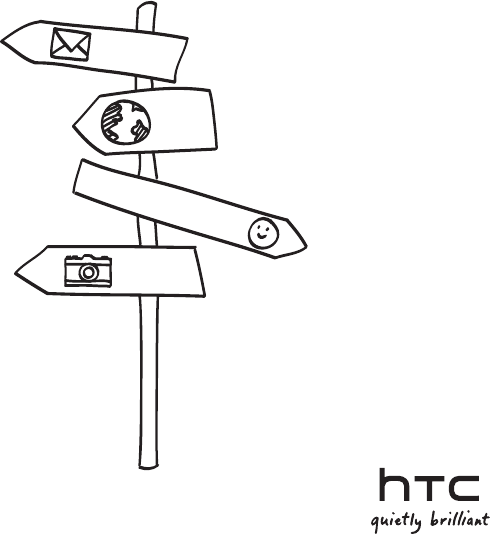
Your HTC Aqua
User guide
2
Before you do anything else, please read this
Charge the battery
The battery in your phone hasn’t been charged yet. While your phone is
charging, it’s important that you do not remove the battery pack. Doing so can
damage your phone. Also, please don’t try to take your phone apart. (If you do,
it may invalidate your warranty.)
Choose a rate plan wisely
Your phone can use up a lot of Internet bandwidth really quickly. Before you
use your phone, we strongly recommend that you talk to your mobile operator
about data rates. If you’re on a standard data plan, the costs could really add up.
Switching to a flat-rate plan could be a lot cheaper.
Know about privacy laws
Some countries have strict laws about how and when you can record phone
conversations. For example, you may need to tell the person you’re speaking to
before you start recording. It’s a good idea to find out what the laws are where
you live before you use your phone’s recording feature.
And finally, a few important words from our legal team
(LIMITATION OF DAMAGES)
To the maximum extent permitted by applicable law, in no event shall HTC or
its affiliates be liable to you, any user, or third party for any indirect, special,
consequential, incidental or punitive damages of any kind, arising in contract,
tort, or otherwise, including, but not limited to, injury, loss of revenue, loss
of goodwill, loss of business opportunity, loss of data, and/or loss of profits,
regardless of the foreseeability thereof or whether HTC or its affiliates have
been advised of the possibility of such damages. And in no event shall the total
liability of HTC or its affiliates exceed the amount received from you, regardless
of the legal theory under which the cause of action is brought. The foregoing
does not affect any statutory rights which may not be disclaimed.

3
A note about location services
Your phone is designed to make it easy for you to access a wide variety of
content. For your protection, we want you to be aware that some applications
that you enable may involve the location of your phone being shared. For
applications available through AT&T, we offer privacy controls that let you
decide how an application may use the location of your phone and other
phones on your account. However, the AT&T privacy tools do not apply to
applications available outside of AT&T. Please review the terms and conditions
and the associated privacy policy for each location-based service to learn how
location information will be used and protected. In addition, your AT&T phone
may be used to access the Internet and to download, and/or purchase goods,
applications, and services from AT&T or elsewhere from third parties. AT&T
provides tools for you to control access to the Internet and certain Internet
content. These controls may not be available for certain devices which bypass
AT&T controls.
Please also read the Safety and regulatory guide that is included in the box
for information on the proper usage of your phone to prevent injuries and to
avoid damaging your phone. You can also refer to this guide for regulatory
information about your phone.
You can also visit our support website at www.htc.com/support to download
the Safety and regulatory guide and to access other helpful resources for
your phone.
Trademarks and copyrights
Copyright © 2010 HTC Corporation. All Rights Reserved.
The HTC logo, the HTC quietly brilliant logo, HTC Xxxx, HTC Sense, HTC Sync,
and HTC Care are trademarks of HTC Corporation.
© 2010 AT&T Intellectual Property. All rights reserved. AT&T, the AT&T logo
and all other AT&T marks contained herein are trademarks of AT&T Intellectual
Property and/or AT&T affiliated companies.
4
Bluetooth and the Bluetooth logo are trademarks owned by Bluetooth SIG, Inc.
microSD is a trademark of SD Card Association.
Google, the Google logo, and Gmail are trademarks of Google Inc.
Java, J2ME and all other Java-based marks are trademarks or registered
trademarks of Sun Microsystems, Inc. in the United States and other countries.
Copyright © 2010, Sun Microsystems, Inc. All Rights Reserved.
Facebook is a trademark of Facebook, Inc.
Twitter is a trademark of Twitter, Inc., and is used under license.
Licensed by QUALCOMM Incorporated under one or more of the following
patents:
4,901,307 5,490,165 5,056,109 5,504,773 5,101,501 5,778,338
5,506,865 5,109,390 5,511,073 5,228,054 5,535,239 5,710,784
5,267,261 5,544,196 5,267,262 5,568,483 5,337,338 5,659,569
5,600,754 5,414,796 5,657,420 5,416,797
Brew is a trademark of Qualcomm Incorporated.
All other company, product and service names mentioned herein are trademarks,
registered trademarks or service marks of their respective owners.
HTC shall not be liable for technical or editorial errors or omissions contained
herein, nor for incidental or consequential damages resulting from furnishing
this material. The information is provided “as is” without warranty of any kind
and is subject to change without notice. HTC also reserves the right to revise the
content of this document at any time without prior notice.
No part of this document may be reproduced or transmitted in any form or
by any means, electronic or mechanical, including photocopying, recording or
storing in a retrieval system, or translated into any language in any form without
prior written permission of HTC.
5
Contents
Chapter 1 Basics
Inside the box .................................................................................................................8
Your phone ..................................................................................................................... 9
Bottom cover ................................................................................................................. 11
Battery compartment door ..................................................................................... 12
SIM card ..........................................................................................................................13
Storage card .................................................................................................................14
Battery ............................................................................................................................16
Starting up .....................................................................................................................19
Finger gestures ............................................................................................................ 21
Keyboard ....................................................................................................................... 22
Chapter 2 Getting started
Getting to know the Home screen ...................................................................... 28
Personalizing the Home screen ............................................................................38
Accessing apps in the All programs panel .......................................................42
Phone status and notifications .............................................................................43
Connecting your phone to a computer .............................................................46
Adjusting the volume ...............................................................................................48
Getting the most out of your battery ................................................................49
6
Chapter 3 Phone calls
Making calls ................................................................................................................... 51
Receiving calls ............................................................................................................54
Using in-call options .................................................................................................56
Checking the call history ........................................................................................58
Call settings .................................................................................................................59
Chapter 4 Staying close
Opening the People application ..........................................................................60
Adding and managing contacts ............................................................................ 61
Contact groups ...........................................................................................................64
Linking to your contacts’ Facebook profiles ................................................... 65
Friend Stream ..............................................................................................................66
Contact information and conversations............................................................69
Chapter 5 Exchanging messages
Text and multimedia messages ............................................................................70
Email messages .......................................................................................................... 77
Chapter 6 Getting connected
Data connection .........................................................................................................84
Browsing the web ......................................................................................................86
Using Bluetooth ..........................................................................................................90
7
Chapter 7 Camera and multimedia
Camera basics .............................................................................................................96
Viewing photos and videos .................................................................................. 101
Listening to music ................................................................................................... 103
Chapter 8 More apps
Weather ....................................................................................................................... 106
Calendar ...................................................................................................................... 108
Alarm .............................................................................................................................111
File Browser .................................................................................................................112
Java ........................................................................................................................... 114
FM Radio .......................................................................................................................116
Chapter 9 Managing your phone
Changing the phone’s basic settings .................................................................118
Protecting your phone ........................................................................................... 120
Settings on your phone ...........................................................................................121
Factory resetting.......................................................................................................126
Index 127

Chapter 1
Basics
Inside the box
You will find the following inside the box:
Phone
Battery (preinstalled)
USB cable
Power adapter
Power plug
3.5mm stereo headset
microSD card
Quick start guide
Safety and regulatory guide
•
•
•
•
•
•
•
•
•
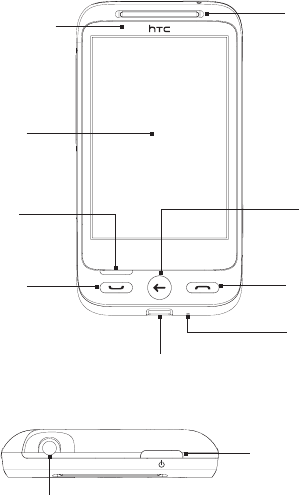
Chapter 1 Basics 9
Your phone
Front panel
Microphone
USB connector
Notification LED
Earpiece
Touch screen
BACK/HOME
END CALLCALL
MENU
Top panel
Audio jack
POWER
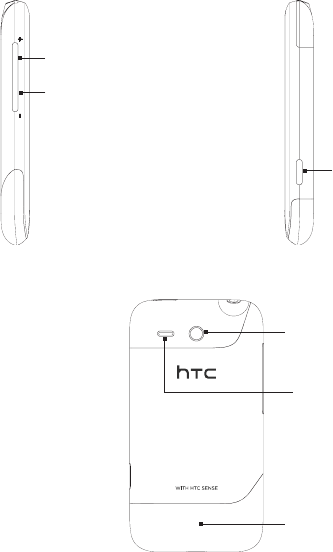
10 Chapter 1 Basics
Left panel Right panel
VOLUME UP
VOLUME DOWN
CAPTURE
Back panel
Camera
Bottom cover
Speaker
Chapter 1 Basics 11
Bottom cover
Removing the bottom cover
Remove the bottom cover to access the battery compartment, SIM
card slot, and storage card slot.
1. With the phone turned off, hold your phone securely with the
front facing down.
2. With your right and left thumbs, push the bottom cover out to
remove it.
Replacing the bottom cover
1. Dock the bottom cover onto the exposed area of your phone’s
back panel.
2. Align the small tabs of the bottom cover with the notches above
the battery compartment, and then push the bottom cover in
place.
Note The two prongs underneath the bottom cover act as the antenna for
your phone. It is recommended that you secure the bottom cover to the
phone to ensure that you get the best radio reception for your phone.
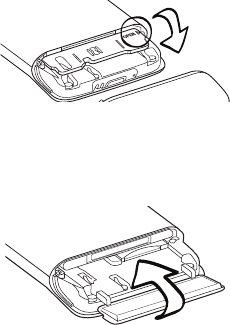
12 Chapter 1 Basics
Battery compartment door
Opening the battery compartment door
1. Remove the bottom cover. Refer to “Removing the bottom
cover.”
2. Open the battery compartment door by flipping it open from the
right side.
Closing the battery compartment door
1. Hold your phone securely with the front facing down.
2. Flip the battery compartment door back into place to close it.
3. Gently push down the battery compartment door until it clicks
into place to lock it.
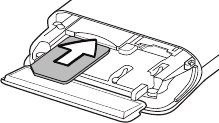
Chapter 1 Basics 13
SIM card
The SIM card contains your phone number, service details, and
phonebook/message memory. Your phone supports both 1.8V and 3 V
SIM cards.
Note Some legacy SIM cards may not function with your phone. You should
consult with your mobile operator for a replacement SIM card. There
may be fees for this service.
Inserting the SIM card
The SIM card slot is located below the battery compartment.
1. Remove the bottom cover. Refer to “Removing the bottom
cover.”
2. Open the battery compartment door. Refer to “Opening the
battery compartment door.”
3. If the battery is installed, you can remove the battery first to
make it easier to insert the SIM card. See “Removing the battery”
in this chapter for details.
4. Insert the SIM card with its gold contacts facing down and its
cut-off corner facing out.
5. Push the SIM card all the way in.
14 Chapter 1 Basics
Removing the SIM card
1. Remove the bottom cover. Refer to “Removing the bottom
cover.”
2. Open the battery compartment door. Refer to “Opening the
battery compartment door.”
3. If the battery is installed, remove the battery first to make it
easier to remove the SIM card. See “Removing the battery” in this
chapter for details.
4. Push the SIM card in to eject it from its slot.
Storage card
Use the microSD card to store your photos, videos, and music. You’ll
find the microSD card already inserted in your phone.
Inserting the storage card
The storage card slot is located below the battery compartment.
1. Remove the bottom cover. Refer to “Removing the bottom
cover.”
2. Open the battery compartment door. Refer to “Opening the
battery compartment door.”
3. If the battery is installed, you can remove the battery first to
make it easier to insert the storage card. See “Removing the
battery” in this chapter for details.
4. Insert the microSD card into the slot with its gold contacts facing
down and push it in until it clicks into place.
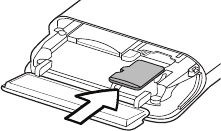
Chapter 1 Basics 15
Removing the storage card
1. Remove the bottom cover. Refer to “Removing the bottom
cover.”
2. Open the battery compartment door. Refer to “Opening the
battery compartment door.”
3. If the battery is installed, remove the battery first to make it
easier to remove the storage card. See “Removing the battery” in
this chapter for details.
4. Push the storage card in to eject it from its slot.
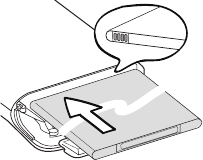
16 Chapter 1 Basics
Battery
Your phone comes with a rechargeable Lithium-ion battery and is
designed to use only manufacturer-specified original batteries and
accessories. Battery performance depends on many factors, including
the features and settings you select and use, signal strength, and the
temperature of the environment in which you operate your phone.
Inserting the battery
1. Remove the bottom cover. Refer to “Removing the bottom
cover.”
2. Open the battery compartment door. Refer to “Opening the
battery compartment door.”
3. Insert the battery with its exposed copper contacts into the
phone first. The exposed copper contacts should be on the right
when you insert the battery.
4. Push the battery all the way in.
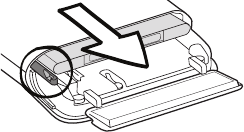
Chapter 1 Basics 17
Removing the battery
1. Remove the bottom cover. Refer to “Removing the bottom
cover.”
2. Open the battery compartment door. Refer to “Opening the
battery compartment door.”
3. Pull out the red battery release to expose the battery, and then
pull the battery out.
Charging the battery
The battery is partially charged when shipped. Before you turn on
and start using your phone, it is recommended that you charge
the battery. Some batteries perform best after several full charge/
discharge cycles.
Important • Only the power adapter and USB cable provided with your phone
must be used to charge the battery.
• Do not remove the battery from the phone while you are
charging it.
1. Attach the power plug to the power adapter.
2. Plug the power adapter into the USB connector of your phone.
3. Plug in the power adapter to an electrical outlet to start charging
the battery.

18 Chapter 1 Basics
As the battery is being charged, the notification LED shows a solid
amber light. The light turns to solid green when the phone is fully
charged.
When you charge the battery while the phone is on, the charging
battery icon ( ) is displayed in the status bar or lock screen. After
the battery has been fully charged, a full battery icon ( ) will be
displayed.
Note As a safety precaution, the battery stops charging before it overheats.
Chapter 1 Basics 19
Starting up
After installing your SIM card and battery and charging the battery,
you are now ready to power on and start using your phone.
1. Press and hold the POWER button.
2. If your SIM card is preset with a PIN (Personal Identification
Number), enter the PIN, and then tap OK to proceed.
Note Entering the wrong PIN for three times blocks the SIM card. To find
out how to unlock the SIM card, see “Unblocking a SIM card that has
been locked out” in Chapter 9.
Setting up your phone for the first time
The first time you turn your phone on, you’ll get to choose some basic
phone settings and set up your online accounts such as email and
Facebook®. You may skip the setup if you prefer to do it at another
time.
1. Select a language.
Slide your finger upward to scroll down and see available
languages. Tap a language you want to use and then tap Next.
Note Available languages depend on where you purchased the phone.
2. Choose whether to use location service.
Location service helps determine your current location when
you’re using applications such as Weather. Tap Agree to use
location service so that it can collect your location information. If
you’d rather not, tap Disagree.
Note You can ask your mobile operator to find out whether there are data
charges when you turn this feature on. You can enable or disable
this service later in Settings.
3. Set up your email account. First, tap the type of your email
account or tap Other.
20 Chapter 1 Basics
Note If you selected Other, you may need to enter more account
information, such as the email server settings. Obtain these details
from your email account provider.
4. Tap the Email address and Password items onscreen one at a
time to display the onscreen keyboard and use it to enter your
email address and password.
After entering your email address and password, tap Next.
5. Tap Account name if you want to change the display name of
your email account. You can also tap Your name to change your
display name.
6. Tap Save.
Your phone then connects to the Internet and verifies your email
account information. If your account information is accurate, your
email account is then set up successfully on your phone.
7. Tap New account and follow steps 3 to 6 if you want to set up
another email account, or tap Next to proceed to the next step.
8. Set up your social network accounts such as Facebook and
Twitter. For each account, enter your username or email address
and password, and then tap Login.
After setting up your social network accounts, tap Next.
9. Choose whether to automatically download and update your
current location and the weather information. Tap the On/Off
buttons to turn automatic updates on or off, and then tap Next.
Note You need to accept the location service agreement to be able to
automatically update your location (see step 2).
10. Your phone detects the current time zone and sets your local
time automatically. This may be network-provided or through
location service (if enabled).
If these settings can’t be auto-detected, manually set the current
time, date, and time zone, and then tap Done.
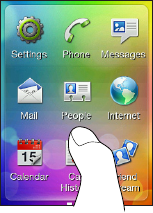
Chapter 1 Basics 21
Finger gestures
Use these easy finger gestures to move around your phone.
Tap
Touch an onscreen item with
your finger.
Double-tap
Quickly touch the screen twice.
Press and hold
Touch an area or item without
lifting your finger immediately.
Drag
Press and hold an item, and then
move your finger with some
pressure. Do not release it until
you have reached the target
position.
Slide or swipe
Move your finger vertically or
horizontally across the screen.
Flick
Move your finger up or down in
light, quicker strokes.
Pinch
In some applications, like Photos or the web browser, you can “pinch”
the screen using two fingers (for example, thumb and index fingers)
to zoom in or zoom out when viewing a picture or a web page.
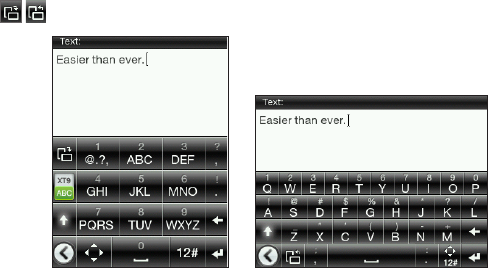
22 Chapter 1 Basics
Keyboard
When you tap an item and it requires you to enter text or numbers,
the onscreen keyboard becomes available.
Choosing a keyboard layout
When entering text, you can choose between these keyboard layouts:
Phone Keypad. This layout resembles the traditional mobile
phone keypad. When you select this keyboard layout, the whole
screen becomes Portrait orientation.
QWERTY. This layout is similar to a computer keyboard. When
you select this keyboard layout, the whole screen becomes
Landscape orientation.
Tap these keys to switch between Phone Keypad and QWERTY.
Phone Keypad QWERTY
Note Some keys may change when multiple keyboard languages are enabled.
For details, see “Enabling multiple keyboard languages” in this chapter.
•
•
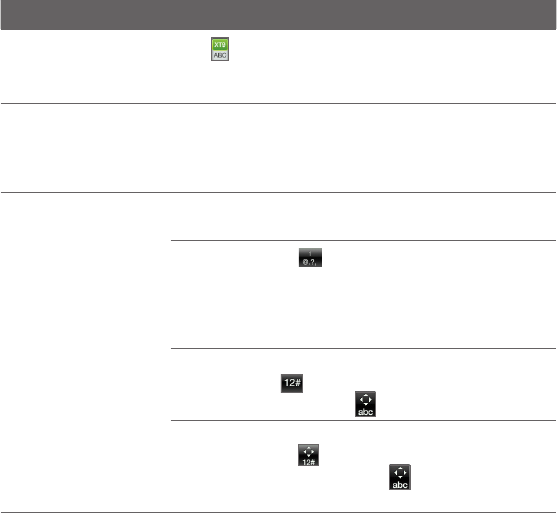
Chapter 1 Basics 23
Entering text using the Phone Keypad
To Do this
Choose an input
mode
Tap to switch between XT9 predictive mode
and ABC mode. For details on using XT9, see
“Using word prediction” in this chapter.
Enter letters Tap a key once to enter the first letter, twice to
enter the second letter, or three times to enter
the third letter that is shown on the key.
Note Make sure that the ABC input mode is enabled.
Enter numbers,
symbols, and
accented
characters
Press and hold a key to enter a number that is
shown on the upper half of the key.
Press and hold to display a selection bar
of commonly used punctuation marks and
symbols. Drag your finger to the punctuation
mark or symbol that you want to select and
insert to your text.
If you only have one keyboard language
enabled, tap to switch to the numeric and
symbol keyboard. Tap to enter letters again.
If you have enabled multiple keyboard
languages, tap to switch to the numeric
and symbol keyboard. Tap to enter letters
again.

24 Chapter 1 Basics
Enter letters in
uppercase
Tap the Shift key ( ) to enter an uppercase
letter.
Tap the Shift key ( ) twice to turn Caps Lock
on.
Delete a character Tap the Delete key ( ) to erase the previous
character entered.
Create a new line Tap the Enter key ( ).
If a text field does not allow multiple lines,
tapping this key closes the onscreen keyboard.
Move the text
cursor
If you only have one keyboard language
enabled, tap . Use the onscreen arrow keys
to move the text cursor.
If you have enabled multiple keyboard
languages, press and hold . Use the
onscreen arrow keys to move the text cursor.
Change keyboard
layout
Tap to switch to QWERTY (displayed only
in landscape orientation). For details, see
“Entering text using QWERTY” in this chapter.
Hide the keyboard Tap when you’re done typing and you want
to close the onscreen keyboard.
Tip You can also press the BACK/HOME button.
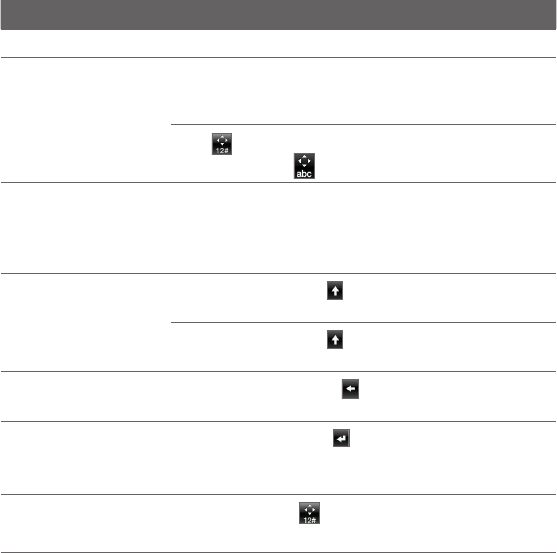
Chapter 1 Basics 25
Entering text using QWERTY
To Do this
Enter letters Tap a letter shown on the lower half of a key.
Enter numbers and
symbols
Press and hold a key to enter a punctuation
mark, symbol, or number that is shown on the
upper half of the key.
Tap to switch to the numeric and symbol
keyboard. Tap to enter letters again.
Enter accented
characters
associated with a
letter
Press and hold a key to display a selection bar
(if accented characters are available). Drag
your finger to the accented character that you
want to select and insert to your text.
Enter letters in
uppercase
Tap the Shift key ( ) to enter an uppercase
letter.
Tap the Shift key ( ) twice to turn Caps Lock
on.
Delete a character Tap the Delete key ( ) to erase the previous
character entered.
Create a new line Tap the Enter key ( ).
If a text field does not allow multiple lines,
tapping this key closes the onscreen keyboard.
Move the text
cursor
Press and hold , and then use the onscreen
arrow keys to move the text cursor.
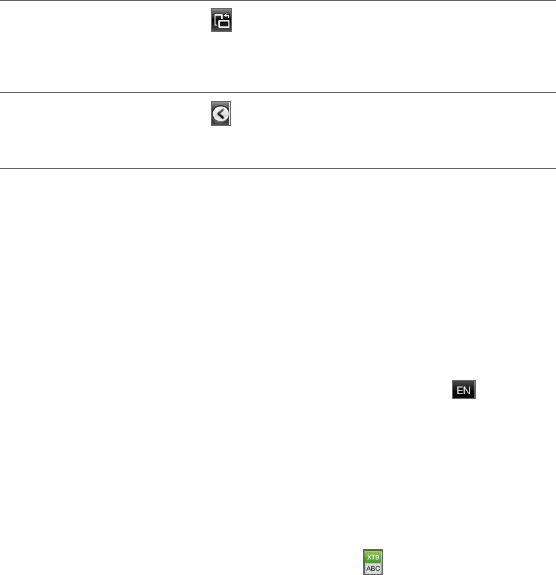
26 Chapter 1 Basics
Change keyboard
layout
Tap to switch to Phone Keypad (displayed
only in portrait orientation). For details, see
“Entering text using the Phone Keypad” in this
chapter.
Hide the keyboard Tap when you’re done typing and you want
to close the onscreen keyboard.
Tip You can also press the BACK/HOME button.
Enabling multiple keyboard languages
If there are multiple keyboard languages available on your phone, you
can choose which languages to enable in the onscreen keyboard so
that you can switch to these languages and use them to enter text.
1. While on the main Home screen, press MENU, and then tap
Settings > Locale & text > Text input settings > Keyboard
languages.
2. Tap one or more languages.
After enabling languages, you’ll see a Language key at the
bottom row of the onscreen keyboard (for example, for
English). Tap the Language key to switch to another language.
Note Available languages depend on where you purchased the phone.
Using word prediction
Word prediction helps you enter text faster. As you type, word
suggestions appear so you can just select the right word from the list.
1. Switch to predictive text input:
When using Phone Keypad, tap XT9 ( ).
When using QWERTY, Prediction is enabled by default.
•
•

Chapter 1 Basics 27
Tip To turn QWERTY’s word prediction on or off, go to Settings >
Locale & text > Text input settings > Input options > QWERTY
Keypad > Prediction.
2. Start entering the first few letters of a word. As you enter each
letter, suggested words are displayed.
If you don’t see the word that you want, tap the down arrow icon
( ) to see more suggestions.
3. Tap a word to insert it into your text. You can also tap the Space
key ( ) to accept the highlighted word in the suggestion list
and insert it to your text.
Text input settings
You can set various options for the onscreen keyboard. From the main
Home screen, press MENU, and then tap Settings > Locale & text >
Text input settings.
Setting Description
Keyboard languages Select one or more languages that the keyboard
uses when Prediction, Word completion, and Spell
correction are enabled.
Input options Choose what text input features to enable or disable
in each keyboard layout. You can turn on or off
Prediction, Word completion, and Spell correction.
Sound feedback Turn the typing sound on or off.
Vibrate feedback Choose whether to make the keys vibrate when you
tap them.
Tutorial Learn the basics of using the onscreen keyboard with
the interactive tutorial.
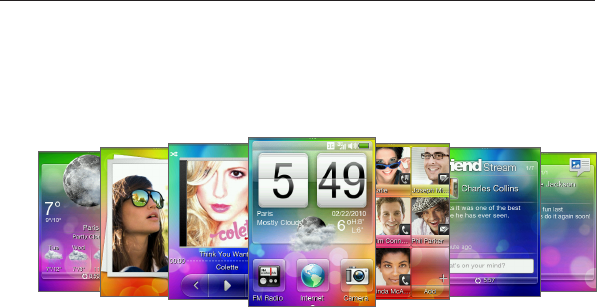
Chapter 2
Getting started
Getting to know the Home screen
Essential features that you need from your phone are right upfront on
the Home screen. Simply slide your finger left and right to go to the
other Home screen panels and see your new messages, check weather
forecasts, listen to music, and more.
The Home screen is customizable. You can remove, replace, or add
features that fit your lifestyle. You can also change the wallpaper. To
find out how to customize the Home screen, see “Personalizing the
Home Screen” in this chapter.
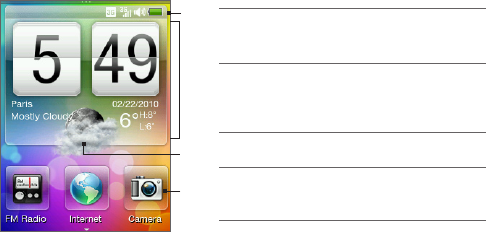
Chapter 2 Getting started 29
Main Home screen
On the main Home screen, you can check the time, date, and weather
of your current location, or add shortcuts to your favorite applications.
11Status bar. For details, see
“Phone Status and Notifications”
in this chapter.
2Weather clock. Tap the time in
the weather clock to set up the
clock with alarms. For details,
see “Alarm” in Chapter 8.
3Current weather. Tap to update
the weather information.
4Home shortcuts. Your one-
touch access to frequently-used
applications.
2
3
4
Slide your finger up the screen to show more Home shortcut slots so
you can add more shortcuts. For details, see “Adding and removing
Home shortcuts” in this chapter.
Returning to the main Home screen
If you’re on another part of the Home screen, simply press the
BACK/HOME button to return to the main Home screen.
If you’re in an application or a settings screen, you can press and hold
the BACK/HOME button to directly go to the main Home screen.
Tip Pressing the BACK/HOME button while on the main Home screen opens
the All programs panel. For details, see “Accessing Applications in the
All Programs Panel” in this chapter.

30 Chapter 2 Getting started
People
Add the people who matter most to you on the People screen so you
can quickly make calls or send text and email messages without going
through your contacts list.
1 Tap the contact’s name to open
his or her contact card.
2 Depending on the
communication method you
have set for a favorite contact,
tap a contact photo to call or
send a message.
3 Indicates the type of
communication method you’ve
selected as default for this
contact.
1
2
3
Adding favorite contacts to the People screen
You need to have contacts already stored on your phone before you
can add them as favorite contacts to the People screen. If there are no
existing contacts, add them first to your phone. To find out how, see
“Adding and Managing Contacts” in Chapter 4.
Note SIM card contacts cannot be added as favorite contacts.
1. From the main Home screen, slide to the People screen.
2. Tap an empty slot.
3. Select a contact.
4. On the Default action screen, choose what contact method to
use for the favorite contact (phone call, text message, or email).
You can add up to twelve favorite contacts to the People screen.
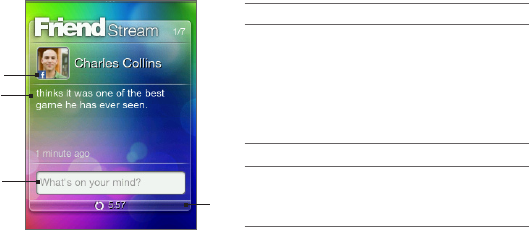
Chapter 2 Getting started 31
Tips • To remove a favorite contact, press and hold a contact photo, drag it
away from its current slot, and then release.
• While on the People screen, press MENU, and then tap All to open the
People application and access your complete list of contacts. To know
more about the People application, see Chapter 4.
Friend Stream
Find out what everyone is saying in your social networks. From the
main Home screen, slide to the Friend Stream screen. Right on Friend
Stream, catch the latest buzz in Facebook, follow tweets on Twitter,
and update your status to these social networks simultaneously.
Note You need to be connected to the Internet and logged in to at least one
social network to download status updates.
1
1 Shows the type of social network.
2 Displays a friend’s latest Facebook
or Twitter status update. Tap
it to open the Friend Stream
application and do more with your
social network account. To know
more about this application, see
“Friend Stream” in Chapter 4.
3 Tap to enter your status message.
4Indicates the time the Friend
Stream screen was last updated.
Tap this bar to refresh the screen.
2
3
4
Slide up or down the Friend Stream screen to view the next or
previous Facebook or Twitter update. While viewing a status update,
you can do the following:
If the current update displayed is from Facebook, press MENU to
view comments, or post your own comment.
•
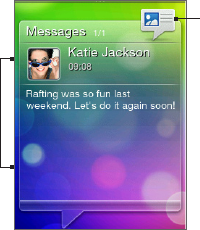
32 Chapter 2 Getting started
If the current update displayed is from Twitter, press MENU to
reply to the tweet or send a direct message (DM) to the person
who posted the tweet.
Posting your status message
1. On the Friend Stream screen, tap the box that says “What’s on
your mind?”.
2. Enter your status message.
3. When prompted, tap OK.
Friend Stream will post your status message simultaneously to the
social network accounts that you have signed in on your phone.
Tip If you do not want your status message to be sent to a certain social
network, press MENU while on the Friend Stream screen, tap Settings,
and then clear the check box of that social network.
Messages
Browse through received text and multimedia messages on this
screen.
Tap the current
message displayed
to open and read the
message as well as
previous messages
between you and the
sender.
Tap to open
the Messages
application.
•
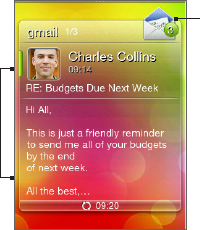
Chapter 2 Getting started 33
On the Messages screen, you can slide up or down the screen to view
the next or previous message. You can also press MENU, and then
choose whether to compose a new message, go to the inbox, or to
reply to, forward, or delete the current message onscreen. For details
about working with text and multimedia messages, see Chapter 5.
Mail
After you have set up your webmail or a POP3/IMAP email account
on your phone, you can use the Mail screen to browse through your
received email messages.
Note If you have set up several email accounts, the Mail screen displays the
email messages from your default email account.
Tap the email to
open and read
the complete
email message.
Tap to open the
Mail application.
On the Mail screen, slide up or down the screen to view the next or
previous email. You can also press MENU, and then choose whether to
refresh the screen, compose a new email, go to the inbox, or to reply
to, forward, or delete the current email onscreen. For details about
working with email, see Chapter 5.

34 Chapter 2 Getting started
Photos
The Photos screen displays the most recently
viewed photo on your phone. You can tap the
photo to open the Photos application and view
more photos and videos stored on your phone
and storage card.
When you press MENU while on the Photos
screen, you can:
Share or delete the current photo.
Assign the current photo to a contact or
set it as the lock screen wallpaper.
•
•
Music
Enjoy listening to music on the go. Copy songs and music albums to
your storage card and listen to them right on the Music screen. For
details on copying files, see “Copying files to or from your storage
card” in this chapter.
Tap to open the Music
application. For details,
see “Listening to
Music” in Chapter 7.
Playback controls
Repeat mode
Shuffle mode

Chapter 2 Getting started 35
After copying songs to your storage card, slide to the Music screen,
and then use the playback controls to play, pause, or go to the
previous or next song.
You can also:
Tap the Shuffle mode icon to toggle between turning the Shuffle
mode on or off.
Tap the Repeat mode icon and choose whether to repeat the
current track ( ), repeat all tracks in the current album or
playlist ( ), or not to repeat (the Repeat mode icon is grayed
out).
Weather
The Weather screen displays your current weather information and
weather forecasts for the next four days of the week.
Tap today’s weather
information to
open the Weather
application. For
details, see “Weather”
in Chapter 8.
Indicates the time the
Weather screen was
last updated.
Tap this bar to
download the latest
weather information.
Note You need to be connected to the Internet to download weather
information.
•
•
36 Chapter 2 Getting started
Adding a city
1. On the Weather screen, tap the text that says “Tap to select a
city”.
2. Enter the first few letters of a country or city name. The screen
then displays a matching list of locations.
3. Scroll through the list, and then tap the name of the desired city.
Tip To switch to another city on the Weather screen, press MENU, tap Select
a city, and then tap a city to display. You need to add more cities first in
the Weather application. To find out how, see “Weather” in Chapter 8.
Updating weather information automatically
1. From the Weather screen, press MENU, and then tap Settings.
2. Turn on Download weather automatically, if it’s off. When
prompted, tap Yes.
3. Tap Update frequency, and then select a time interval.
Note Turn on Download weather when roaming only when you want to use
this feature. This may incur additional data charges.
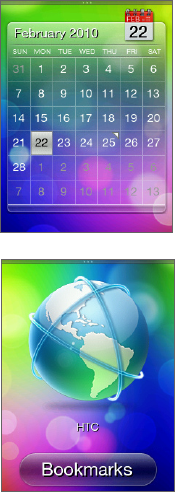
Chapter 2 Getting started 37
Calendar
The Calendar screen displays a month
calendar with markers to inform you of the
dates that have scheduled and events.
Tap a date to open view its scheduled
events. You can also press MENU to
create an event or view your agenda.
Slide up or down the screen to display
the next or previous month. Press MENU,
and then tap Today to display the current
month again.
To know more about the Calendar application,
see “Calendar” in Chapter 8.
•
•
Internet
Easily search for information on the Web. Slide
to the Internet screen, and then tap the globe
image to open your phone’s web browser.
Tap Bookmarks to open a list of
bookmarks stored on your phone.
Press MENU to open your set home page
or view your browsing history.
To know more about the Internet application,
see Chapter 6.
•
•
38 Chapter 2 Getting started
Personalizing the Home screen
Make your phone look just the way you want it. Personalize the Home
screen with a different wallpaper and customize it with the features
that you want.
Personalizing with scenes
Your phone becomes multiple phones in one when you use scenes.
Scenes are personalized Home screen configurations that you can
quickly apply to your phone to suit your mood - be it for work or play.
You can even create your own scene to fit your lifestyle and daily
needs.
Choosing a scene
There are preset scenes that you can directly apply to your Home
screen. Each one is preconfigured with a different wallpaper and
collection of features.
To select and apply a scene, do one of the following:
From the main Home screen, press MENU and tap Scenes. Then
tap the scene you want to use.
Go to any part of the Home screen. Slide open the Notifications
panel from the top of the screen, and then tap a scene under
Scene selection. For information about the Notifications panel,
see “Notifications panel” in this chapter.
Creating and saving a new scene
You can make changes to the Home screen and lock screen, and save
your customization as a new scene.
1. Start from a preset scene, or select Clean slate if you want to
design your own scene. To find out how to select a scene, see
“Choosing a scene”.
•
•
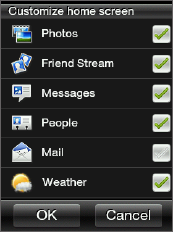
Chapter 2 Getting started 39
2. You can do the following to customize your scene:
Add shortcuts to frequently-used applications. For details, see
“Adding and removing Home shortcuts”.
Customize the Home screen with features that you need for
your day-to-day use. For details, see “Filling the Home screen
with features that you want”.
Change the Home screen wallpaper and the lock screen
wallpaper. To find out how, see “Changing the home
wallpaper” and “Changing the lock screen wallpaper”.
3. When you are done designing your scene, return to the main
Home screen. Then press MENU and tap Scenes.
4. Under My scenes, make sure the Current(unsaved) option is
selected.
5. Press MENU, tap Save, and then enter a new scene name.
Filling the Home screen with features that you want
Except for the main Home screen, you can
add or change what features you want to
use on the other six Home screen panels.
1. From the main Home screen, press
MENU, and then tap Customize.
2. Choose what features you want to
add or remove on the Home screen by
selecting or clearing their check boxes.
3. Tap OK.
Note You can add or remove features on the
Home screen panels, but their order
cannot be arranged.
•
•
•
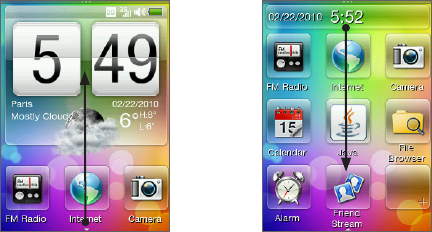
40 Chapter 2 Getting started
Adding and removing Home shortcuts
Home shortcuts give you one-touch access to your favorite
applications. You can add up to nine shortcuts.
On the
main Home
screen,
slide up
to access
available
slots for
adding
shortcuts.
Slide down
to show the
weather
clock again.
Tip You can also add or remove Home shortcuts in Settings > Personalize >
Home shortcuts.
Adding a Home shortcut
1. Slide your finger up on the main Home screen, and then tap an
empty slot.
2. Browse through the list of applications, and then tap a favorite
application to add.
Note Shortcuts cannot be replaced. If you want to change a slot with another
shortcut, you need to remove the shortcut that occupies that slot first,
and then add the new shortcut.
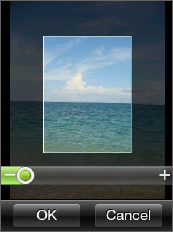
Chapter 2 Getting started 41
Removing a Home shortcut
1. Press and hold the shortcut that you want to remove.
2. When the screen dims out, drag the shortcut away from its slot.
3. Release your finger when the icon is outside the slot.
Changing the home wallpaper
1. From the main Home screen, press MENU, and then tap
Wallpaper.
2. Tap Home, and then browse for the photo you want to use.
3. Crop the part of the photo that you
want to set as the wallpaper.
While cropping, you can:
Change the orientation of the
photo. Press MENU, and then tap
Rotate left or Rotate right.
Zoom in or out using the
onscreen zoom bar.
Drag the photo to frame a part of
it within the crop box. Everything
outside the crop box will be
discarded.
•
•
•
4. Tap OK.
Changing the lock screen wallpaper
1. From the main Home screen, press MENU, and then tap
Wallpaper > Lock screen.
2. Select a photo, crop as needed, and then tap OK.
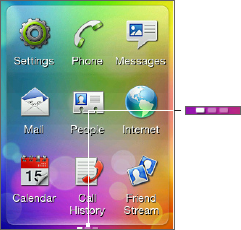
42 Chapter 2 Getting started
Accessing apps in the All programs panel
See what applications your phone has in store for you in the All
programs panel.
1. From the main Home screen, press the BACK/HOME button.
Tip If you’re in an application or a settings screen, you can press and
hold the BACK/HOME button to directly go to the main Home
screen.
2. Slide left to scroll the panel sideways and access more
applications.
The small horizontal
bars at the bottom of
the panel indicate that
there are several pages
of applications. They
show you which page
you’re currently in.
3. Tap an application to open it.
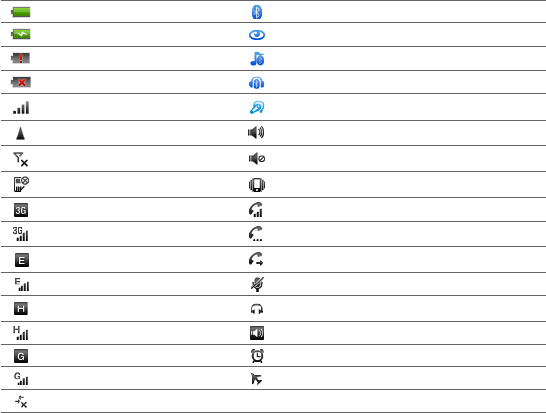
Chapter 2 Getting started 43
Phone status and notifications
Below are some of the status icons and notification icons that you
may see in the status bar and on the lock screen.
Status icons
Full battery Bluetooth on
Battery charging Bluetooth visible
Low battery Bluetooth stereo headset connected
Very low battery Bluetooth stereo music only
Maximum signal strength Bluetooth hands-free only
Roaming Sound on
Phone connection is off Silent mode on
No SIM card inserted Vibration mode on
3G available Call is in progress
3G connected Call on hold
EDGE available Calls are forwarded
EDGE connected Mute
HSDPA available Wired headset connected
HSDPA connected Speakerphone on
GPRS available Alarm is set
GPRS connected Airplane mode
No data connection
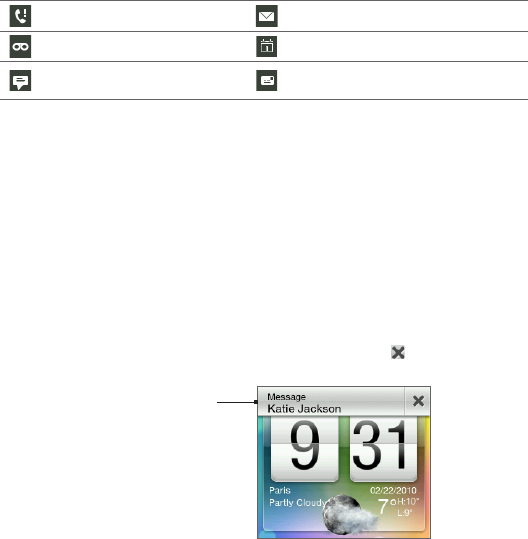
44 Chapter 2 Getting started
Notification icons
Missed call New mail
New voicemail Upcoming event
New SMS/MMS General notification
(appears in the status bar only)
Notification LED
The notification LED shows a:
Solid green light when the battery is fully charged.
Solid amber when the battery is charging.
Flashing amber when the battery level is low.
Flashing green when there’s a pending notification.
Notification popup
When you have a missed call, new SMS/MMS, new voicemail, or
upcoming event, a notification popup appears on the upper side of
the screen. Tap the notification to check it, or tap to dismiss the
notification.
Notification
popup
•
•
•
•
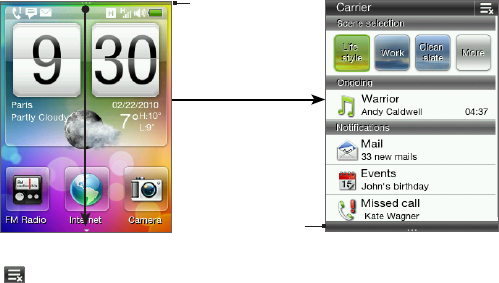
Chapter 2 Getting started 45
Notifications panel
The Notifications panel shows you how many new notifications you
have. It also displays the current status of ongoing processes, such as
the duration of an ongoing phone call, upload and download status
messages, music playback duration, and more.
Open the Notifications panel from the Home screen. Slide your finger
downward, starting from the topmost part of the Home screen.
Drag this thin border
down to open the
Notifications panel.
Notifications panel
Drag this bar
up to close the
Notifications panel.
Tap to clear all notifications in the Notifications panel.
Tip You can also press the BACK/HOME button to close the
Notifications panel.
46 Chapter 2 Getting started
Connecting your phone to a computer
Whenever you connect your phone to a computer using the USB
cable, a selection screen opens on your phone and prompts you
to choose the type of USB connection. You can select one of the
following choices:
Mount SD card. This option is available only when you have
inserted a microSD card on your phone. Select this option to
connect your phone’s storage card to your computer as a USB
drive so you can copy files between the storage card and your
computer.
HTC Sync. Select this option to use the HTC Sync software on
your computer to sync with your phone. For details, see “About
HTC Sync”.
Charge only. Select this option if you just want to charge the
phone’s battery using your computer.
Copying files to or from your storage card
1. Connect your phone to your computer using the USB cable that
came with your phone.
2. On the USB connected screen, tap Mount SD card, and then tap
OK.
3. On your computer, the connected phone is recognized as a
removable disk (just like any USB drive). Open this removable
disk so you can see what’s inside the microSD card.
Note While the phone’s storage card is connected to the computer as a
USB drive, you won’t be able to use applications on your phone to
access the storage card.
4. Copy files from your computer to your phone’s storage card, or
copy files from the storage card to your computer.
•
•
•
Chapter 2 Getting started 47
5. After copying, unmount the removable disk (that is, the
connected phone) as required by your computer’s operating
system to safely remove your phone.
About HTC Sync
You can use HTC Sync™ to synchronize contacts, calendar, and other
information between your computer and your phone.
Download and install the HTC Sync version for HTC Aqua from our
support website, www.htc.com/support, when it’s available.
Note Visit the HTC support website from time to time to download and install
the most recent HTC Sync upgrade.

48 Chapter 2 Getting started
Adjusting the volume
To Do this
Adjust the system
volume
(volume level of the
phone ringtone and
sound notifications)
Press the VOLUME UP/DOWN button
(except during a call or when playing
music/video). Slide up or down the volume
bars or continue pressing the VOLUME
UP/DOWN button to increase or decrease
the system volume.
Tip Tap Silent to mute the volume or Vibrate
to switch the phone to Vibration mode.
Adjust the media
volume
(volume level of music
or video)
Press the VOLUME UP/DOWN button
when playing music or watching a video.
Slide up or down the volume bars or
continue pressing the VOLUME UP/DOWN
button to increase or decrease the media
volume
Adjust the voice
volume
(in-call volume level)
Press the VOLUME UP/DOWN button
during a call. Slide up or down the volume
bars or continue pressing the VOLUME
UP/DOWN button to increase or decrease
the in-call volume
Note The Volume screen automatically closes. You can also tap an empty area
of the Volume screen to close it.
Chapter 2 Getting started 49
Getting the most out of your battery
When you’re on the go, it’s not always easy to charge your phone’s
battery as often as you’d like. Follow these tips to extend the time
between charges:
Switch the phone to Sleep mode when not in use (see “Switching
to Sleep mode”).
Turn the power off, if you won’t be using your phone for
extended periods of time (see “Turning the power off“).
Turn Bluetooth off immediately after you’re done using it. For
details, see “Turning Bluetooth on or off” in Chapter 6.
Lower the screen brightness. From the main Home screen, press
MENU, tap Settings > Display > Brightness, and then decrease
the brightness.
Cut down on activities such as Internet browsing which consume
a lot of power.
Avoid making very long phone calls or using the camera for
extended periods of time.
Try to carry a spare battery in times when you can’t charge your
battery for an extended period.
Batteries gradually lose capacity over time. Replace your battery
when you notice that the battery life is decreasing.
•
•
•
•
•
•
•
•
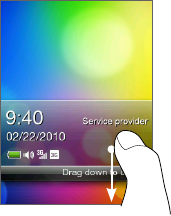
50 Chapter 2 Getting started
Switching to Sleep mode
Switching to Sleep mode turns the display off and automatically locks
the screen to avoid accidental key presses.
Briefly press the POWER button.
Your phone also automatically goes into Sleep mode when the
screen timeout is set and you leave the phone idle after a certain
period of time. For details on setting the screen timeout, see
“Display” in Chapter 9.
Note Press the POWER button again to wake up the phone.
Locking and unlocking the screen
The screen automatically locks when
phone is in Sleep mode.
To unlock the screen, briefly press the
POWER button to wake up the phone,
and then drag down the bar on the lock
screen.
Note The phone screen automatically
unlocks when you receive a call.
•
•
Turning the power off
1. Press and hold the POWER button.
2. Tap Power off.
•
•
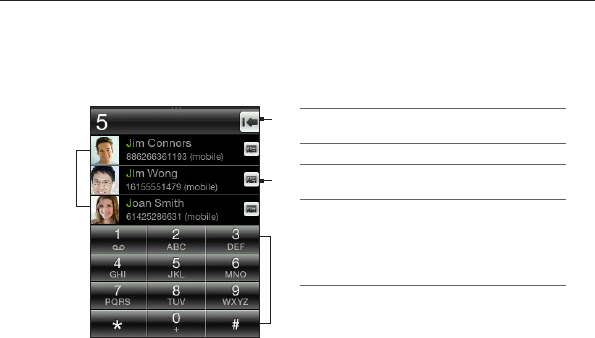
Chapter 3
Phone calls
Making calls
Press the CALL button to open and use the Phone dialer to place your
calls. You can enter a phone number, call a stored contact, or check
the Call History.
1
2
3
41 Lists the search results based
on the entered keys.
2 Keypad
3 Tap to open the person’s
contact card.
4 If you entered a wrong digit,
tap this button to erase it.
Press and hold this button to
erase the entire number and
start all over again.
•
•
Tip You can also open the Phone dialer by tapping Phone from the All
programs panel.
Dialing a number or a contact
You can either dial a number directly, or you can use the Phone
dialer’s Smart Dial feature to quickly place a call to a stored contact or
a number in the Call History.
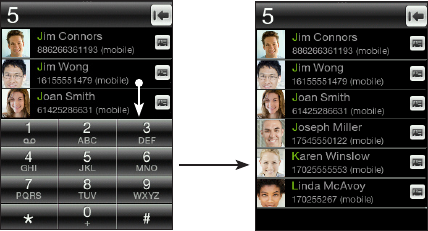
52 Chapter 3 Phone calls
1. Press the CALL button to open the Phone dialer.
2. Begin entering the first few digits or characters. As you enter
numbers or letters, you’ll see matching names from the stored
contacts in your phone and SIM card as well as numbers from the
Call History.
Press MENU,
and then
tap Keypad
to show
the keypad
again.
You can
view more
matching
results
when you
slide down
the filtered
list to hide
the keypad.
3. To call a number or contact, do one of the following:
Tap a contact or number from the filtered list.
If you are calling a phone number that’s not stored in your
phone, enter the complete number, and then press the CALL
button.
Using Speed dial
Use Speed Dial to quickly call frequently-dialed numbers.
Note The number 1 speed dial key is pre-assigned to your voicemail. You
cannot delete Voicemail from the Speed dial list.
•
•

Chapter 3 Phone calls 53
Assigning a speed dial number to a contact
1. Press the CALL button to open the Phone dialer.
2. Press MENU, and then tap Speed dial.
Tip You can also press and hold an unassigned numeric key.
3. Tap an unused numeric key, and then do any of the following:
Tap Name, select a contact list type, and then tap a contact.
Tap OK.
Note If the stored contact has multiple phone numbers, make sure
to select the frequently-dialed phone number shown under the
contact’s name.
If the phone number you want to assign to the speed dial key
is not stored in your phone or SIM contacts, tap Phone, and
then enter the complete number.
4. Press MENU, and then tap Save.
Calling a speed dial number
Press and hold an assigned speed dial key on the Phone dialer to dial
the associated contact’s number.
Editing or deleting a speed dial number
1. Press the CALL button to open the Phone dialer.
2. Press MENU, tap Speed dial, and then do any of the following:
To Do this
Edit a speed dial
entry
Tap the assigned speed dial key, and then
tap the Name or Phone field to choose or
enter another number.
Delete a speed dial
number assignment
Tap the assigned speed dial key, press
MENU, and then tap Clear.
•
•

54 Chapter 3 Phone calls
Delete all speed dial
assignments
On the Speed dial screen, press MENU,
and then tap Clear. When prompted, tap
OK.
Directly making calls from received messages
While viewing a text or multimedia message, press MENU, and then
tap Call to directly place a call to the sender without opening the
Phone dialer.
If you are viewing an email message, press the CALL button. The
Phone dialer screen then opens, with the sender’s phone number
automatically filled in. Press the CALL button again to dial the number.
For details on viewing text and email messages, see Chapter 5.
Note When placing a call from a received email, make sure that the contact’s
email address and phone number are already stored in your phone.
Receiving calls
When you receive a call, an incoming voice call screen shows you the
contact’s name, phone number, and photo (if available).
Answering or rejecting calls
To Do this
Answer a call Press the CALL button.
Mute the ring without
rejecting the call
Press the VOLUME DOWN button.
Reject a call Press the END CALL button.
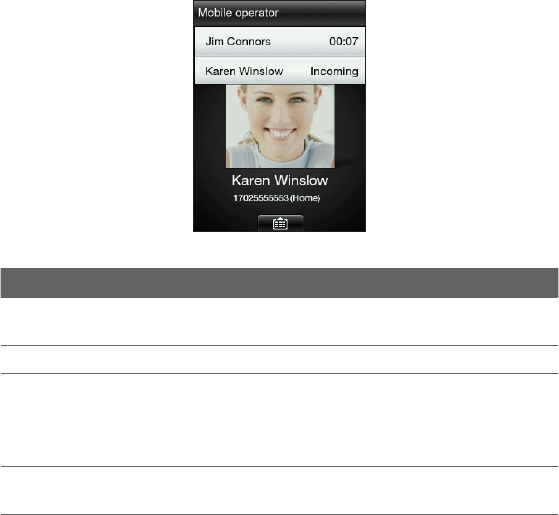
Chapter 3 Phone calls 55
Handling multiple calls
When there is another incoming call while you are already in a call,
you will hear a notification sound from the earpiece and see a new
incoming voice call screen.
To Do this
Answer the second call Press the CALL button. This puts the first
call on hold.
Reject the second call Press the END CALL button.
Switch calls After answering both calls, press the CALL
button to switch from one call to another.
Tip You can also press MENU, and then tap
Switch call.
Merge calls After answering both calls, press MENU,
and then tap More > Merge calls.

56 Chapter 3 Phone calls
Dial a number or
contact while in a call
While in a call, press MENU, and then do
any of the following:
• Place a second call. Tap People to select
a contact to call, or tap Keypad to dial a
phone number.
• Start a conference call by tapping
Add call. For details, see “Setting up a
conference call” in this chapter.
Note Placing another call puts the ongoing call
on hold.
Using in-call options
During a call, you can do any the following:
To Do this
Put a call on hold Press the CALL button. You can also press
MENU, and then tap Hold call.
Unhold a call When a call is on hold, press the CALL
button. You can also press MENU, and then
tap Unhold call.
End a call Press the END CALL button.
Access the Phone
dialer keypad
When you need to access the Phone dialer
keypad (for example, if you want to enter
an extension number), tap Keypad ( ).

Chapter 3 Phone calls 57
Turning the speakerphone on or off during a call
Press and hold the CALL button to toggle between turning the
speakerphone on or off. The speakerphone icon ( ) appears in the
status bar when the speakerphone is on.
Important! To decrease potential damage to your hearing, do not hold your
phone against your ear when the speakerphone is on.
Setting up a conference call
Before starting a conference call, make sure your SIM card is enabled
with conference calling service.
1. Press the CALL button to open the Phone dialer.
2. Make a call to the first conference call participant.
3. When connected, press MENU, and then tap Add call.
4. To dial the second participant, do any of the following:
Enter the phone number, and then press the CALL button.
Press MENU, and then tap People. Tap a contact list type,
select a contact, and then tap the number you want to call.
Calling the second participant puts the first call on hold.
5. Press MENU, and then tap More > Merge calls.
6. Add more participants by repeating steps 3 to 5.
7. During a call, you can press MENU, and then do one of the
following:
Tap Speaker on to turn on the speakerphone.
Tap Mute to turn off the microphone.
•
•
•
•

58 Chapter 3 Phone calls
Checking the call history
The Call History logs all dialed, received, and missed calls. This lets you
easily return a missed call or save a new phone number listed.
To open Call History, you can:
Tap a missed call notification from the Notifications panel.
Press the CALL button to open the Phone dialer, press MENU,
and then tap Call history.
Open the All programs panel, and then tap Call History.
To Do this
Return a call Tap a contact in Call History, and then tap the
number to call.
Or, tap an unsaved phone number, and then tap
Call (phone number).
Save a phone
number
Tap the phone number in Call History, and then
select Save to new contact or Add to existing
contact. For details, see “Adding and Managing
Contacts” in Chapter 4.
Filter call logs On the Call History screen, press MENU, and then
tap View. Select the type of calls you want to
display.
Delete one or
more call logs
On the Call History screen, press MENU, and then
tap Delete. Select one or more entries, and then
tap OK.
•
•
•

Chapter 3 Phone calls 59
Call settings
You can enable or disable various phone services from your mobile
operator. Press the CALL button to open the Phone dialer, press
MENU, and then tap Settings.
Setting Description
Fixed dialing number Restrict outgoing calls to a fixed set of numbers. To
enable this feature you must know your SIM card’s
PIN2 code.
Call forwarding Select how you want your phone to handle busy,
unanswered, and unreachable calls. You can also set
the call forwarding option for all incoming calls.
Call barring Choose whether to block various categories of
incoming and outgoing calls.
Additional call
settings
Enable or disable operator services such as caller ID
and call waiting.
Voicemail number Change the voicemail number stored on the phone.
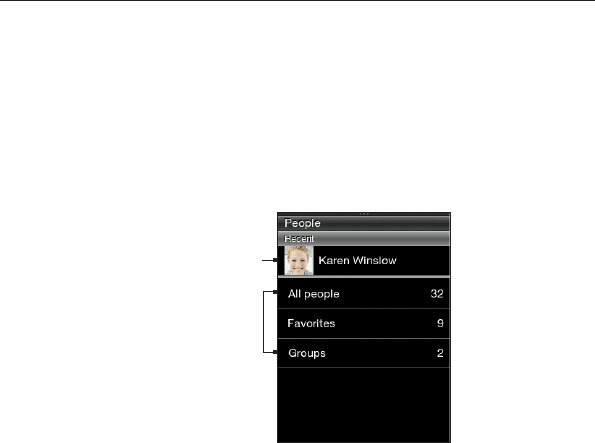
Chapter 4
Staying close
Opening the People application
In People, you can easily manage your communications with contacts.
To open the People application, you can:
From the main Home screen, slide to the People screen. Press
MENU, and then tap All.
Open the All programs panel, and then tap People.
While you’re using the Phone dialer, press MENU, and then tap
People.
Last call log
is displayed
(if available).
Contact lists
•
•
•

Chapter 4 Staying close 61
Adding and managing contacts
Create new contacts on your phone or import existing ones from your
SIM card.
Note When you open the People application for the first time, you will be
asked whether to import SIM card contacts to your phone. Tap OK to
import.
Creating new contacts on your phone
1. Open the People application.
2. Press MENU, and then tap New contact.
3. Tap Phone to create a new contact on your phone.
4. Tap Add name, enter the contact’s first and last name, and then
tap OK.
5. Tap Add photo, select an album, and then do any of the
following:
Tap an existing photo for the contact.
Tap the Camera icon ( ). Press the CAPTURE button to
take a photo, and then tap Save.
Crop the photo as needed, and then tap OK.
6. Tap Add phone. Select a phone number type, and then enter the
contact’s phone number.
If the contact has multiple phone numbers, you can tap Add
phone again to add another one.
7. Fill in other details, such as the email address, postal address, and
ringtone to use for the contact.
8. When contact details are complete, tap OK.
•
•
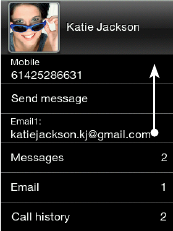
62 Chapter 4 Staying close
A new contact card is added. Tapping a contact in People lets
you view his or her contact card.
Slide your finger up to view
more contact details or open
exchanged messages with this
contact.
Adding contacts to your SIM card
1. Open the People application.
2. Press MENU, and then tap New contact.
3. Tap SIM to create a new contact on your SIM card.
4. Enter the contact’s details, and then tap OK.
Tips • You can also copy the contacts stored in your phone to your SIM
card. Open a contact card, press MENU, and then tap Save to SIM.
• To access your SIM card contacts, open the People application, press
MENU, and then tap SIM manager.
Finding contacts
1. Open the People application, and then tap All people.
2. Press MENU, and then tap Search people.
3. Begin entering the first few digits or characters of a phone
number or a name. A search results panel displays matching
names from the stored contacts in your phone.
Chapter 4 Staying close 63
Note Search people uses the same search behavior of Smart Dial. For
details, see “Dialing a number or a contact” in Chapter 3.
4. Tap a contact to open his or her contact card.
Editing contact details
1. Open the People application.
2. Select a contact list type, and then tap a contact.
3. Press MENU, and then tap Edit.
4. Tap an item to edit, and then enter the new information.
5. Tap the contact photo to choose another photo.
Note When you have linked to your contact’s Facebook profile, you can
select to use his or her Facebook profile photo.
6. On the Edit contact screen, tap OK to save your changes.
Sharing contact cards
1. Open the People application.
2. Select a contact list type, and then tap a contact.
3. Press MENU, and then tap Send contact.
4. Choose how you want to share the contact card. For more
information, see “Text and Multimedia Messages” in Chapter 5
and “Using Bluetooth” in Chapter 6.
Deleting a contact
1. Open the People application.
2. Select a contact list type, and then tap a contact.
3. Press MENU, and then tap Edit.
4. Scroll down the Edit contact screen, and then tap Delete contact.
5. When prompted, tap Delete.
64 Chapter 4 Staying close
Contact groups
By organizing contacts into groups, sending messages to several
contacts is a lot easier. Using groups to categorize contacts is also a
way of filtering the contacts list so that browsing and finding contacts
can be faster and easier.
Creating a group
1. Open the People application, and then tap Groups.
2. Press MENU, and then tap New.
3. Tap Name, and then enter a group name.
4. Tap Add people, select the contacts you want to include, and
then tap OK.
5. After entering the group name and members, tap OK.
Editing a group
1. Open the People application, and then tap Groups.
2. Tap a group.
3. Press MENU, and then tap Edit.
4. Edit the group’s name or modify its members.
Note You can also delete a group on the Edit group screen. Deleting a
group does not delete its members’ contact details.
5. Tap OK to save your changes.
Sending photos and messages to groups
1. Open the People application, and then tap Groups.
2. Tap a group.
Chapter 4 Staying close 65
3. Press MENU, and then tap any of the following:
Send message. When sending a text or multimedia message,
the message will be addressed to the Mobile number (by
default) of each contact. For details, see “Text and Multimedia
Messages” in Chapter 5.
Send mail. Make sure that all group members have saved email
addresses. If there are multiple email addresses, Email1 will be
used by default. For details, see “Email Messages” in
Chapter 5.
Send photo. You can take a photo or choose an existing one
on your phone. This will be added as an attachment to your
multimedia message. For details, see “Text and Multimedia
Messages” in Chapter 5.
Linking to your contacts’ Facebook profiles
When you have set up your Facebook account on your phone,
matching contacts are automatically linked to their Facebook profiles
to keep you updated of the latest buzz from your friends.
Contacts are matched when their names in People are the same with
your friends in Facebook.
Note You need to be logged in to your Facebook account.
Manually linking to contacts’ Facebook profiles
1. Open the People application.
2. Select a contact list type, and then tap a contact.
3. Scroll down the screen, and then tap Link to Facebook.
•
•
•
66 Chapter 4 Staying close
4. Do any of the following:
If suggested matches are found, you can tap a Facebook
friend from the list.
Tap Search, enter your friend’s first name and last name, and
then tap Save. On the Matched Facebook link screen, tap a
Facebook friend.
Note Tapping Save without entering a name displays all of your Facebook
friends.
Viewing Facebook updates of a contact
1. Open the People application.
2. Select a contact list type, and then tap a contact.
3. Scroll down the screen, and then tap View updates. The contact’s
recent Facebook updates are then displayed.
Friend Stream
Friend Stream simplifies the way that you tend to your social
networks. Your interaction with friends in multiple social networks like
Facebook and Twitter are brought into a single stream of updates.
You can also conveniently post the same status message to your
social network accounts.
Note You need to be logged in to your social network accounts to download
Friend Stream updates.
•
•
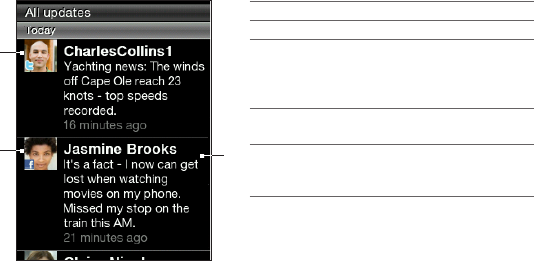
Chapter 4 Staying close 67
Opening Friend Stream
Do any of the following:
Open the All programs panel, and then tap Friend Stream.
From the main Home screen, slide to the Friend Stream screen
(if it is available or you’ve added it to the Home screen). Tap the
status message or tweet currently displayed to open the Friend
Stream application.
1
1 Twitter update
2 Facebook update
3 Tap to view more options. For
details, see “Connecting with
your friends in Facebook” and
“Following tweets” in this chapter.
Slide up and down the screen to view
more Facebook or Twitter updates.
Press MENU, and then tap Refresh to
manually download recent Friend Stream
updates.
23
Logging in to your social networks
If you did not set up your social networks when you were setting up
your phone for the first time, you can still log in to social network
accounts such as Facebook and Twitter.
1. From the main Home screen, press MENU, and then tap
Settings > Data services.
2. Tap a social network account.
•
•

68 Chapter 4 Staying close
3. The screen shows whether you are logged in or not. To open a
login page, tap the social network name.
4. Enter your username or email address and password, and then
tap Login.
Connecting with your friends in Facebook
1. Open Friend Stream.
2. On the All updates screen, tap a Facebook update.
3. Do any of the following:
Option Description
View
comments
Tap to open the Facebook update with comments on the
person’s wall.
Like/Unlike Tap to let the person know you like his or her status
message. Tap Unlike to undo liking it.
Comment Tap to post your comment. Enter your comment, and then
tap OK.
View wall Tap to open the person’s wall in a web browser.
Following tweets
1. Open Friend Stream.
2. On the All updates screen, tap a tweet.
3. Do any of the following:
Option Description
Reply Tap to reply to the tweet.
Send direct
message
Tap to send a private message to the Twitter
user.

Chapter 4 Staying close 69
Retweet Tap to repost the tweet.
Add to my favorite Tap to mark the tweet as a favorite.
Show profile Tap to open the person’s profile in a web
browser.
Uploading wall photos in Facebook
1. Open Friend Stream.
2. On the All updates screen, press MENU, and then tap Upload
photos.
3. Open the album containing the photos to upload.
4. Tap one or more photos, and then tap OK. The photos will then
be uploaded to your wall in Facebook.
Updating your status message
1. Open Friend Stream.
2. On the All updates screen, press MENU, and then tap Status.
3. Enter your status message.
4. When prompted, tap OK.
Contact information and conversations
Interactions such as phone calls and messages are neatly organized
by people, not by applications. When you open a friend’s contact
card, it gives you one-touch access to all of his or her contact details,
messages, email, call logs, and Facebook updates.
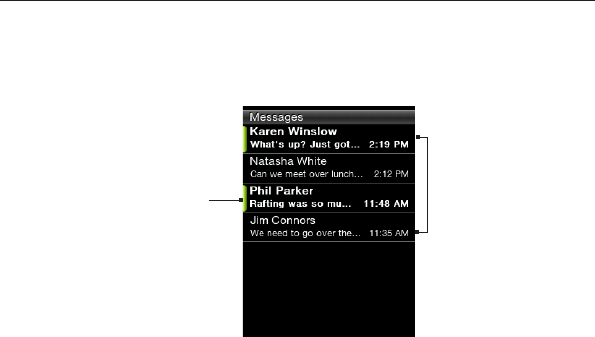
Chapter 5
Exchanging messages
Text and multimedia messages
Keep in touch with important people in your life. When you open the
Messages application, all your received messages are neatly grouped
by conversations per contact.
Each entry here
contains the
conversations
with a contact.
Indicates there’s
a new text or
multimedia message
received from the
contact.
Note To see a list of your message drafts, press MENU while on this screen,
and then tap Drafts.
Opening the Messages application
From the main Home screen, slide to the Messages screen, and
then tap the Messages icon on the upper-right side of the screen.
Open the All programs panel, and then tap Messages.
•
•
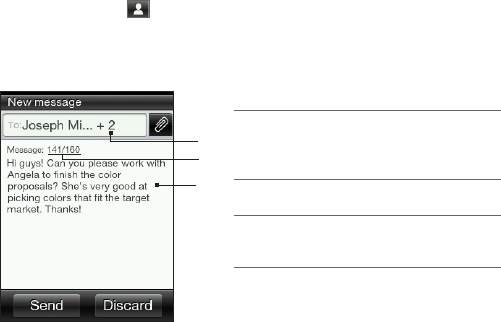
Chapter 5 Exchanging messages 71
Sending text messages
Send text messages (SMS) to other mobile phones. If you exceed the
limit on the number of characters for a single text message, your text
message will be delivered as one but will be billed as more than one
message.
1. Open the Messages application.
2. Press MENU, and then tap New.
3. Tap the To field, and then do any of the following:
Enter the first few characters of a contact’s name, and then
tap a contact from the search results panel. Repeat this step
to add more people.
Tap People ( ). Select a contact list type, tap one or more
contacts, and then tap OK.
Enter a mobile phone number.
4. Tap the message area, enter your message, and then tap Send.
1 Indicates the number of
recipients you’ve added. Tap
this text box again see a list of
your recipients.
2 Indicates the number of
characters entered.
3 Tap the message area to open
the onscreen keyboard and
enter your message.
1
2
3
Tip To save the message first and send it at another time, press MENU,
and then tap Save as draft.
•
•
•
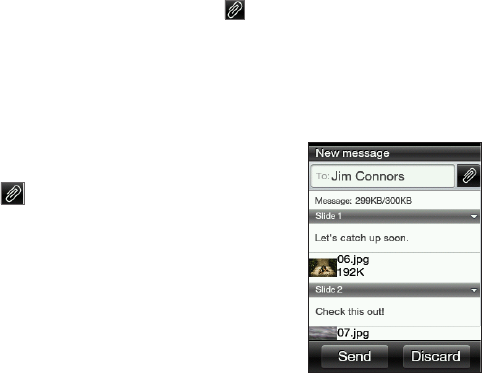
72 Chapter 5 Exchanging messages
Sending multimedia messages
When composing multimedia messages, make sure that the size of the
attachment is within the limits allowed by your mobile operator.
1. Create a new message by following steps 1 to 3 in “Sending text
messages”.
2. Tap the message area, and then enter your message.
3. To include a file attachment, tap , and then choose the type of
attachment. Browse and select the file to attach.
4. To add a subject, press MENU, and then tap Add subject.
5. When you have finished composing your multimedia message,
tap Send.
Creating a slideshow in your multimedia message
1. Create a new message by following
steps 1 to 3 in “Sending text messages”.
2. Tap to include attachments, and then
tap Photo.
3. Select an album, and then tap a photo to
attach.
4. On the message area, tap the text that
says “Tap to add text”, and then enter a
caption for the attached photo.
5. To add another slide, press MENU, and
then tap Slide options > Add slide.
6. On the message area, tap the slide bar that appears after adding
a new slide. You can then choose to add a photo or audio, edit
your caption, and more.
7. To add another slide, repeat steps 5 and 6 to add a photo or
other attachments.
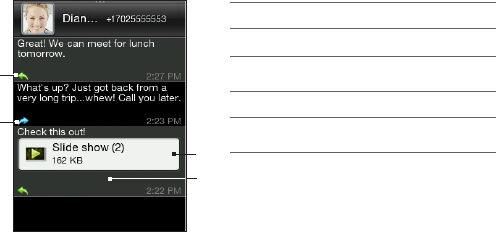
Chapter 5 Exchanging messages 73
8. To view your slideshow, press MENU, and then tap Preview.
9. Press the BACK/HOME button to return to the New message
screen.
10. When you are done with your slideshow, tap Send.
Viewing conversations with a contact
Open the Messages application and tap a conversation to view all the
messages between you and a contact.
If you received a new message from a contact, you can also slide
open the Notifications panel, and then tap the message notification to
read the new message and the other messages between you and the
contact.
1
1 Sent message indicator
2 Received message indicator
3 Tap to see more message
options.
4 Attachment indicator
Slide up and down the screen to view
more messages in the conversation.
4
2
3
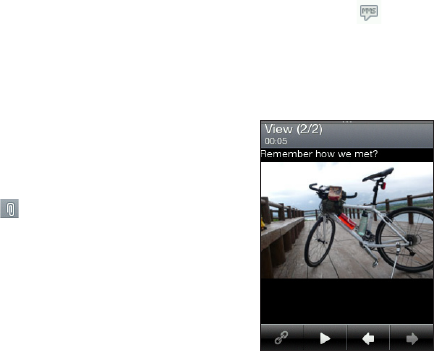
74 Chapter 5 Exchanging messages
Viewing a multimedia message
1. Open the Messages application.
2. Multimedia messages are marked with an MMS icon ( ). Tap a
multimedia message you want to open.
3. Tap the attachment indicator. The media attachment, such as a
photo, video, audio, or slideshow, is then played.
4. While viewing the multimedia message, you can:
Use the onscreen buttons to pause,
play, or to move forward and
backward in a slideshow.
If there’s a contact card attachment,
tap ( ). To save the contact
information to your phone, tap the
contact, and then tap Save.
5. To save the media attachments to
your phone, press the BACK/HOME
button to go back to the conversation
between you and the contact.
•
•
6. Tap the multimedia message (not the attachment indicator), and
then tap Save content.
7. Select one or more files, and then tap Save.
Note Downloaded multimedia attachments are saved in the Downloads
folder of your phone storage.
Replying to a message
1. Open the Messages application.
2. Tap the contact you want to reply to.
Chapter 5 Exchanging messages 75
3. Press MENU, and then tap Reply.
4. Enter your response, and then tap Send.
Forwarding messages
1. Open the Messages application.
2. Tap the contact whose message you want to forward.
3. Tap a message within the conversation, and then tap Forward.
4. On the New message screen, tap the To field, and then enter one
or more contacts.
5. When done, tap Send.
Copying a message to your SIM card
1. Open the Messages application.
2. Tap the contact whose message you want to save to your SIM
card.
3. Tap a message within the conversation, and then tap Copy to
SIM.
Deleting a message or a whole conversation
Deleted messages and conversations are only moved to the Deleted
items list and you can still recover them, or permanently remove them
from your phone.
Deleting messages within a conversation
1. Open a conversation with a contact.
2. Press MENU, and then tap Delete selected.
3. Select one or more messages to remove from the conversation,
and then tap Delete.

76 Chapter 5 Exchanging messages
Deleting a whole conversation
1. On the main Messages screen, press MENU, and then tap Delete.
2. Select one or more conversations, and then tap Delete.
Clearing the Deleted items list
1. On the main Messages screen, press MENU, and then tap Deleted
items.
2. Deleted messages and conversations are then displayed. Press
MENU, and then tap Clear all.
Message settings
On the main Messages screen, press MENU, and then tap Settings.
Setting Description
Message options You can enable message settings, such as delivery
reports and validity period of messages.
MMS server Select from a list of preconfigured MMS settings.
Cell broadcast Enable or disable receipt of cell broadcast messages
from your service provider.
Edit quick text Select from a list of quick text templates to edit.
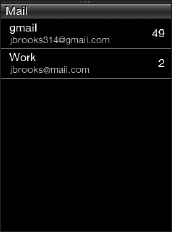
Chapter 5 Exchanging messages 77
Email messages
The Mail application lets you send and receive email messages from
your webmail or other accounts, using POP3 or IMAP.
To open the Mail application, open the All programs panel, and then
tap Mail.
Email accounts list
Setting up your email accounts
Before you can send and receive email messages, you need to set up
one or more of your email accounts on your phone. If you did not set
up email when you were setting up your phone for the first time, you
can still add your email accounts.
Setting up your first email account
1. Open Mail.
2. Tap an email account type. If your email account type is not in
the list, see “Setting up other POP3/IMAP email accounts” in this
chapter.
3. Enter your email address and password, and then tap Next.
78 Chapter 5 Exchanging messages
4. Tap Account name if you want to change the display name of
your email account. Tap Your name to change your display name.
5. Tap Save. After login is successful, Mail then downloads new
messages from your email account.
Note If synchronization does not start automatically, press MENU, and
then tap Refresh.
Setting up multiple email accounts
1. Open Mail.
2. After setting up your first email account, notice that the inbox
of your first email account is displayed. Press the BACK/HOME
button to go back to the email accounts list.
3. Press MENU, and then tap New account.
4. Set up another email account by following steps 2 to 4 in
“Setting up your first email account”.
Note When setting up an account with the same email provider, you need
to save the second email account with a different account name.
5. If you’ll be setting up multiple email accounts, choose whether to
make this account your default email account.
6. Tap Save. After login is successful, Mail then downloads new
messages from your email account.
Note If synchronization does not start automatically, press MENU, and
then tap Refresh.
Chapter 5 Exchanging messages 79
Setting up other POP3/IMAP email accounts
You may need to enter more information, such as incoming and
outgoing servers, that you can get from your email provider.
1. Open Mail.
If you have an email account already set up, press the
BACK/HOME button to go back to the email accounts list first.
Press MENU, and then tap New account.
2. Tap Other.
3. Enter your email address and password, and then tap Next.
4. Enter additional account details, and then tap Next.
5. Tap Account name if you want to change the display name of
your email account. Tap Your name to change your display name.
6. If you have multiple accounts, choose whether to make this
account your default email account.
7. Tap Save. After login is successful, Mail then downloads new
messages from your email account.
Note If synchronization does not start automatically, press MENU, and
then tap Refresh.
Editing an email account
1. Open Mail.
2. Do any of the following:
If you have only one email account set up, press MENU, and
then tap Edit account.
If you have multiple email accounts, press MENU while in the
email accounts list, and then tap Edit account. Select the email
account to modify.
3. Tap a field to edit, enter the new information, and then tap Save.
•
•
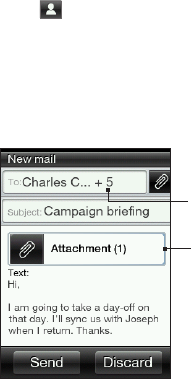
80 Chapter 5 Exchanging messages
Sending email messages
1. Open Mail.
If you have multiple email accounts, select the email account in
the email account list.
2. In your inbox, press MENU, and then tap New.
3. Tap the To field, and then do any of the following:
Enter the first few characters of a contact’s name, and then
tap a contact from the search results panel. Repeat this step
to add more people.
Tap People ( ). Select a contact list type, tap one or more
contacts, and then tap OK.
Enter one or more email addresses.
Note If you want to send a carbon copy (Cc) or a blind carbon copy
(Bcc) of the email to other people, press MENU, and then tap Show
cc/bcc.
4. Enter a subject.
Attachment
indicator
Tap to view more
recipients you’ve
added.
5. Tap the message area, and then enter your message.
•
•
•
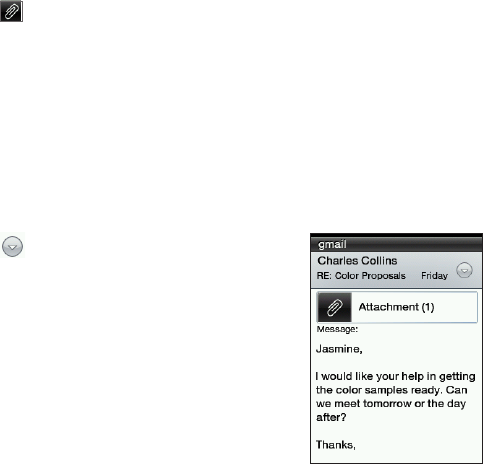
Chapter 5 Exchanging messages 81
6. Tap to include attachments to your email message. Browse
and select one or more files to attach, and then tap OK.
Tip To remove an attachment, tap the attachment indicator, select an
attachment, and then tap Remove.
7. Tap Send.
Note You can also press MENU, and then tap Save as draft. To open the
Drafts folder, see “Switching to other folders” in this chapter.
Viewing email messages
Open your mail inbox, and then tap an email you want to read. When
viewing an email message, you can:
Tap to view the recipients in the
loop. If you want to save a new email
address, tap the email address, and then
choose whether to create a new contact
or add it to a stored contact.
If available, tap the More button to
continue downloading the complete
email message.
Call the sender of the email. For details,
see “Directly making calls from received
messages” in Chapter 3.
•
•
•
82 Chapter 5 Exchanging messages
Replying to an email message
1. Open Mail.
2. Tap an email to open it.
3. Press MENU, and then tap Reply. Or, if there are other recipients
included in the email, tap Reply all.
4. Tap the message area, and then enter your response.
5. Tap Send.
Downloading attachments
1. Open Mail.
2. Tap an email that contains one or more attachments, and then
tap the attachment indicator.
3. On the Attachment screen, tap an attached file to download, and
then tap Save.
4. Browse for a folder where you want to save the file, and then tap
Save.
Forwarding email messages
1. Open Mail.
2. Tap an email to open it.
3. Press MENU, and then tap More > Forward.
4. On the Forward mail screen, tap the To field, and then enter one
or more contacts.
5. When done, tap Send.
Chapter 5 Exchanging messages 83
Setting how often and how much email to sync to your
phone
1. Open Mail.
If you have multiple email accounts, select the email account in
the email accounts list.
2. Press MENU, and then tap Edit account > Check frequency.
3. Select a time interval for downloading email messages.
4. Tap Advanced settings > Download options, and then select how
many days of email messages to download. You can also tap All
to always download all your email messages.
5. Tap Next to go to the next screen, and then tap Save.
To refresh your inbox and sync email using the new settings,
press MENU, and then tap Refresh.
Switching to other folders
1. Open Mail.
If you have multiple email accounts, select the email account in
the email accounts list.
2. Press MENU, and then tap Folders.
3. Tap a folder you want to open.
Deleting an email account
If you have only one email account on your phone, open Mail,
press MENU, and then tap Delete account.
If you have multiple email accounts on your phone, press MENU
while in the email accounts list, and then tap Delete account.
Select the email account to delete, and then tap OK.
•
•

Chapter 6
Getting connected
Data connection
It’s simple. When you turn your phone on for the first time (with the
SIM card inserted), it should connect automatically to your mobile
operator’s data service. You can start browsing the web straight away.
Note Do not change the connection settings as this may cause services to
stop working. If you’re having problems connecting to the Internet and
you really need to change some settings, see “When There’s a Problem
Connecting to the Internet” in this chapter to find out how to change
them. Please contact your mobile operator for the proper settings.
Turning the data connection on or off
Turning your data connection off can help optimize your battery
life. It can also save money on data charges. However, when
your data connection is turned off, you may not always receive
automatic updates to your email, social network accounts, and other
synchronized information.
1. Press and hold the POWER button.
2. In the Phone options menu, tap Mobile network.
Chapter 6 Getting connected 85
Checking your current network connection settings
Your phone has been set to connect automatically to the Internet
through your mobile operator’s data service. If you don’t get a
connection automatically, check your network connection settings.
1. From the main Home screen, press MENU, and then tap
Settings > Wireless controls > Mobile network settings.
2. Check the following:
Automatic setup is turned on.
The name of your mobile operator is displayed in the Network
operators item.
The right mobile network is displayed in the Access point
names item. If it’s not the right network, tap the Access point
names item and then select the network that your phone
should connect to.
Adding a new access point
If your mobile operator has changed their network connection
settings, obtain their access point name and other settings (including
username and password if required) and add them to your phone.
1. From the main Home screen, press MENU, and then tap
Settings > Wireless controls > Mobile network settings > Access
point names.
2. Press MENU, and then tap New.
3. Enter the APN settings, and then tap Save. On the Access point
names screen, make sure that the new APN is selected.
•
•
•
86 Chapter 6 Getting connected
Browsing the web
Open the web browser to start surfing the web. The browser is fully
optimized and comes with advanced features that let you enjoy
Internet browsing on your phone.
Opening your phone’s web browser
Do one of the following:
Tap the Internet icon if you see it on the main Home screen.
Open the All programs panel and then tap Internet.
If you added the Internet feature to your Home screen, slide to
the Internet screen and then tap the globe image to open the
web browser.
Searching the web
1. While on the browser screen, press MENU, and then tap More >
Web search.
2. Enter a word or phrase to search. When search results are
displayed, tap a link to go to the corresponding website.
Going to a website
On the browser screen, tap the address bar, and then enter a web
address. As you enter the first few characters, popular web addresses
are then listed. You can tap an address from the list or continue
entering the complete web address that you want.
Tip The address bar is always on the top of the web page you are viewing.
After you scrolled down a web page, you can access the address bar by
pressing MENU.
•
•
•

Chapter 6 Getting connected 87
Moving around a web page
Press MENU, and then tap Landscape or Portrait to change the
screen orientation.
Drag your finger in any direction to move around the web page.
Zooming in or out on a web page
Tap the screen twice quickly to zoom in, then tap the screen twice
quickly again to zoom out. You can also use your fingers to pinch or
spread the screen to zoom in and out.
Double tap
an area to
quickly zoom
in or out.
Navigating to the previous or next web page
Press the BACK/HOME button to go to the previous web page
visited.
Press MENU, and then tap Previous or Next to go backward or
forward to recently visited web pages.
•
•
•
•

88 Chapter 6 Getting connected
Adding bookmarks and revisiting bookmarked sites
1. While viewing the website that you want, press MENU, and then
tap Add bookmark.
2. Tap Label, enter a new name if needed, and then tap Done.
3. To revisit a bookmarked site, press MENU while on the browser
screen, tap Bookmarks, and then tap the site that you want.
Tip While on the Bookmarks list, press MENU and then tap Edit to
remove or make changes to a bookmark.
Working with links on a web page
To Do this
Open a linked
web page
Tap an active link. (After tapping and selecting a
link, it will be enclosed in a colored box).
Bookmark a
linked web page
Press and hold an active link, tap Save as a
bookmark, and then tap Done.
Email a link Press and hold an active link, and then tap Send
via email. For details about sending email, see
Chapter 5.
Send a link as a
text message
Press and hold an active link, and then tap Send
via message. For details about sending a text
message, see Chapter 5.

Chapter 6 Getting connected 89
Working with images on a web page
To Do this
Download an
image and save
on your phone
Press and hold an image, and then tap Save
image. Choose whether to save it on the
phone’s built-in storage or your storage card.
Then choose a folder where to save it, and then
tap Save.
Forward an image
as an MMS or
email attachment
Press and hold an image, and then tap Send
image via email or Send image via mms. For
details about sending messages, see Chapter 5.
Choose whether
to display images
when loading
web pages
While on the browser screen, press MENU, and
then tap More > Settings > Display setting. Tap
Load image to switch between turning this
option on and off.

90 Chapter 6 Getting connected
Using Bluetooth
When Bluetooth is turned on, you can:
Connect and use Bluetooth accessories, such as a hands-free
stereo headset or car kit phone.
Exchange information with other Bluetooth-capable devices
(such as your computer or another phone) over a distance of up
to eight meters.
Turning Bluetooth on or off
1. From the main Home screen, press MENU, and then tap
Settings > Wireless controls.
2. Tap Bluetooth’s On/Off switch to switch between turning this
feature on and off.
When Bluetooth is on, you’ll see the Bluetooth icon ( ) in the status
bar or on the lock screen of your phone.
Note Turn Bluetooth off when not in use to save battery power, or in places
where using a wireless device is prohibited, such as on board an aircraft
and in hospitals.
Changing the phone name
The phone name identifies your phone to other Bluetooth devices.
1. From the main Home screen, press MENU, and then tap
Settings > Wireless controls.
2. Tap Bluetooth settings > Device name.
3. Enter the name you want for your phone.
•
•

Chapter 6 Getting connected 91
Making your phone discoverable to other Bluetooth
devices
For other people using a Bluetooth-capable phone or computer to
be able to search and see your phone, you need to make your phone
discoverable.
1. From the main Home screen, press MENU, and then tap
Settings > Wireless controls > Bluetooth settings.
2. If Bluetooth is not yet turned on, tap Bluetooth.
3. Tap Discoverable.
4. Tap Always or choose a time limit for your phone’s Bluetooth
visibility.
After setting your phone to be discoverable, you’ll see the Bluetooth
visible icon ( ) in the status bar or on the lock screen whenever
Bluetooth is turned on.
Tip To disable discoverable mode on your phone, go to Settings > Wireless
controls > Bluetooth settings, tap Discoverable, and then select
Invisible.
92 Chapter 6 Getting connected
Connecting a Bluetooth headset for the first time
Listen to music using a Bluetooth stereo headset, or have hands-free
conversations using a compatible Bluetooth headset.
1. Turn on the Bluetooth headset and make sure that it is set to
discoverable mode.
To find out how to set it to discoverable mode, see the
documentation that came with the headset.
2. On your phone, turn Bluetooth on. (See “Turning Bluetooth on or
off” in this chapter).
3. On the Wireless controls screen, tap Bluetooth settings.
4. Press MENU and then tap Scan.
Your phone starts searching for Bluetooth devices within range
and displays all detected devices.
5. Tap the name of the headset.
6. Enter the passcode supplied with your headset.
Tip You can try “0000” as the passcode. If that does not work, look for
the correct passcode in the headset documentation.
Your phone then tries to connect to the headset. After it’s connected,
you’ll see the name of your headset in your phone’s Bluetooth device
list.
Tip The steps for connecting your phone with a computer or another phone
that has Bluetooth are just about the same as connecting to a Bluetooth
headset. One difference is, you can specify your own passcode to use
for connecting, and the same passcode needs to be entered in the
computer or other phone.

Chapter 6 Getting connected 93
Turning hands-free or stereo music capability off
If what you’re using is a Bluetooth stereo headset, you’ll see the
icon on the main Home screen’s status bar and on the lock screen,
which means that you can use your headset both for listening to
music and for hands-free phone conversations.
You can choose to use your headset purely for listening to music or
only for hands-free phone conversations, if you want to.
1. From the main Home screen, press MENU, and then tap
Settings > Wireless controls > Bluetooth settings > Bluetooth
device list.
2. Tap the name of your headset.
3. Press MENU and then do one of the following:
Tap Disconnect phone to turn off the hands-free capability
of your headset. (To turn hands-free back on, tap Connect
phone.)
Tap Disconnect media to turn off stereo music in your
headset. (To turn stereo music back on, tap Connect media.)
When only stereo music capability is on, you’ll see the status icon
on the main Home screen and on the lock screen. When only hands-
free capability is on, you’ll see the icon.
•
•

94 Chapter 6 Getting connected
Sending information and media files using Bluetooth
You can use Bluetooth to send contact information, calendar events,
and media files from your phone to your computer or another phone
that has Bluetooth.
Note If you’re sending information or files to another phone, that phone must
support the Object Push Profile (OPP) of Bluetooth.
1. Set the receiving device (your computer or the other phone) to
discoverable mode.
Note On your computer, you may also need to set it to “Receive Beams”
or “Receive Files”. See the online help of your computer’s Bluetooth
software for instructions on receiving information over Bluetooth.
2. On your phone, open the application that contains the
information or files you want to send.
To send Do this
Contact card 1. Open the People application and then tap
All people.
2. Tap the contact you want to send.
3. Press MENU and then tap Send contact >
Bluetooth.
Calendar
event
1. Open the Calendar application.
2. On the month calendar, tap the date that
has the event that you want.
3. Tap the event you want to send.
4. Press MENU and then tap Send > Send via
Bluetooth.

Chapter 6 Getting connected 95
To send Do this
Photos, videos
and music files
1. Open the File Browser.
2. Go to the folder containing the photos,
videos, or music files to send.
3. Press MENU, and then tap More > Send >
By Bluetooth.
4. Select the files to send and then tap OK.
Tip You can also send a captured photo using
the Camera application, or use the Photos
application to send several photos and videos
at the same time.
3. Your phone automatically turns Bluetooth on and then starts
searching for Bluetooth devices within range. Tap the name of
the receiving device.
Note If you have not connected with the receiving device before, you
will be prompted by your phone to enter a passcode. Then on
the receiving device, accept the connection and enter the same
passcode.
4. On the receiving device, accept the information or file(s).
Receiving information and media files via Bluetooth
When someone sends you a contact card, calendar event, or media
file via Bluetooth, your phone displays a full-screen notification.
Accept the connection and the information or file, and save it to your
phone.
Note If you have not connected with the other Bluetooth device before, you
may be prompted to authorize the connection and enter a passcode.
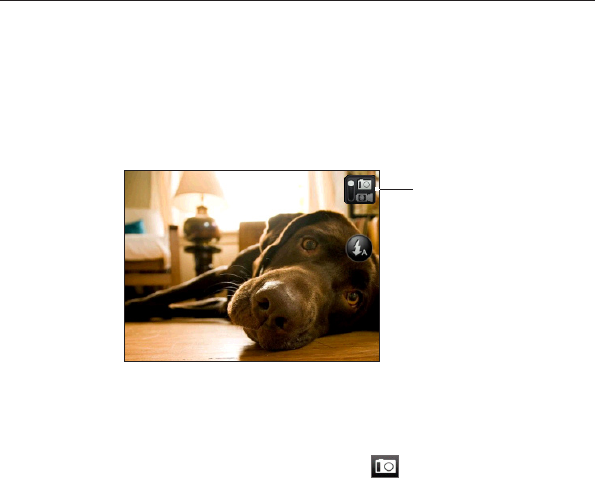
Chapter 7
Camera and multimedia
Camera basics
When something amazing happens right before your eyes, have your
phone camera ready to instantly capture fun shots or record it on
video.
Press the CAPTURE button located at the lower right side of your
phone to open the Camera application. Also use this button as the
shutter release.
Capture
mode switch
Viewfinder screen
Taking a photo
1. Press the CAPTURE button.
2. If the Camera is not in Photo mode ( ), tap the Capture mode
switch.

Chapter 7 Camera and multimedia 97
3. Point the camera at your subject. You can press MENU to access
more camera controls and settings. For details, see “Onscreen
controls” in this chapter.
4. Press the CAPTURE button to take a photo.
Shooting videos
1. Press the CAPTURE button.
2. Tap the Capture mode switch to set to Video mode ( ).
3. Point the camera at your subject. You can press MENU to access
more camera controls and settings. For details, see “Onscreen
controls” in this chapter.
4. Press the CAPTURE button to start recording video. Press this
button again to stop recording.
After taking a photo or video
After capturing, choose what you want to do with the photo or video.
Option Description
Photos. Tap to open and use the Photos application to view the
photos and videos in the phone storage or storage card.
Share. Tap to share the captured photo or video via email,
multimedia message, Bluetooth, or Facebook.
Delete. Tap to delete the photo or video.
Set as. Tap to set the captured photo as a contact photo, lock screen
wallpaper, or home wallpaper.
Play. Tap to view the captured video.
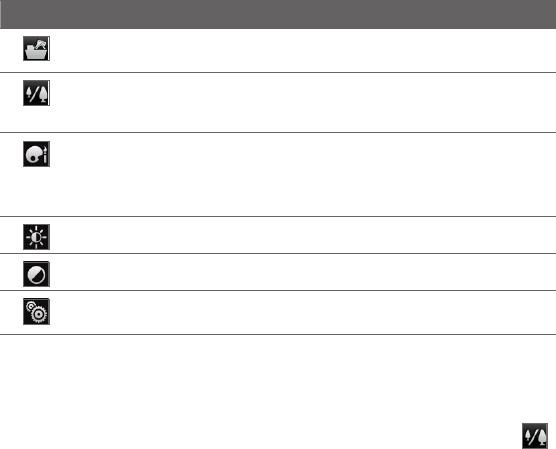
98 Chapter 7 Camera and multimedia
Onscreen controls
Before you start capturing photos and videos, you can press MENU to
access more camera controls and settings.
Option Description
Photos. Tap to open and use the Photos application to view the
photos and videos in the phone storage or storage card.
Zoom. Drag the slider to the left or right to zoom in or out when
capturing a photo or video. For details, see “Zooming” in this
chapter.
Effect. Choose a special effect such as grayscale, sepia, or negative
to apply to your photos and videos.
Note White Balance cannot be applied if an effect has already been
selected. For details, see “Camera settings” in this chapter.
Brightness. Tap to adjust the exposure setting of the camera.
Contrast. Tap to adjust the contrast properties of the camera.
Settings. Access more camera settings. For details, see “Camera
settings” in this chapter.
Zooming
Before taking a photo or video, you can first use the onscreen zoom
bar to zoom in or out of your subject.
1. To display the onscreen zoom bar, press MENU, and then tap .
2. Drag your finger right or left across the zoom bar to zoom in or
out.
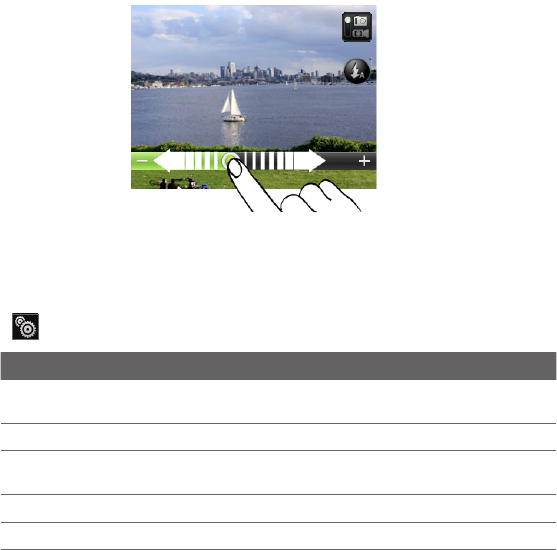
Chapter 7 Camera and multimedia 99
Note In Photo mode, zooming is not available when the maximum resolution
is used for taking photos.
Camera settings
While on the camera’s viewfinder, press MENU, and then tap Settings
( ).
Setting Description
Review after
capture
Tap to turn on or off. When turned on, the captured photo
or video is displayed after pressing the CAPTURE button.
Resolution Select the resolution to use.
White balance Select the white balance settings according to the current
lighting condition to capture colors more accurately.
Video format Select whether to use MPEG4 or H.263 for capturing video.
Quality (Available only in Photo mode) Specify the image quality.

100 Chapter 7 Camera and multimedia
Save to Select where you want to save captured photos and videos.
You can save the files to the phone storage or storage card
(if inserted).
Timer If you need to take a self-portrait or group photo, set the
timer to either 2 or 10 seconds to give yourself time to
position yourself in front of the camera after pressing the
CAPTURE button.
Shutter sound Turn on to play a shutter sound when you press the
CAPTURE button.
Metering mode Set how the camera measures the amount of light to
calculate the best exposure. Choose one of these modes:
Center area mode allows the camera to measure light in
the center.
Average mode allows the camera to measure light in the
entire image.
•
•
Prefix The file name of a newly captured photo is set to “IMAG”
followed by a sequential number (for example, IMAG_009).
You can also choose the current date or date and time as
the file name prefix.
Counter The default file name of photos taken includes a sequential
number at the end (for example, IMAG_009).
Tap Reset to restart the file name counter back to 1.
Flicker
adjustment
When taking indoor shots, flicker on the camera screen may
be caused by interference from fluorescent lighting.
To reduce flicker, change the flicker adjustment setting to
Auto or to the proper frequency (50Hz or 60Hz) of the
country where your phone is being used.
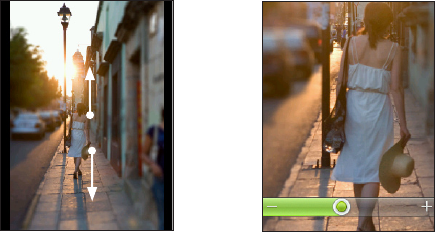
Chapter 7 Camera and multimedia 101
Viewing photos and videos
Using the Photos application, you can view photos and watch videos
that you’ve taken with your phone’s camera, downloaded, or copied
onto your storage card.
Opening the Photos application
Do one of the following:
From the main Home screen, slide to the Photos screen, and then
tap the current photo displayed.
Open the All programs panel, and then tap Photos.
Viewing photos
1. Open the Photos application.
2. Select an album, and then tap a photo to view it in full screen.
3. Slide up or down to go to the next or previous photo.
4. Double-tap the area on the photo you want to zoom in on. To
zoom out, double-tap the screen again.
Slide up to
go to the
next photo
or video.
Slide
down to
go to the
previous
photo or
video.
Drag right or
left across
the zoom bar
to gradually
zoom in or out.
Double-tap an
area to quickly
zoom in or out.
•
•
102 Chapter 7 Camera and multimedia
You can also use pinch zooming. Press your thumb and index
finger on the screen and then spread your fingers apart to zoom
in. Pinch your fingers together to zoom out.
Viewing photos as a slideshow
1. Open the Photos application.
2. Tap an album to open.
3. Press MENU, and then tap Slideshow. You can tap the screen to
display and use the playback controls.
Watching videos
1. Open the Photos application.
2. Select an album, and then tap a video to view it in full screen.
3. While the video is playing, you can tap the screen to display and
use the playback controls.
Sharing photos or videos
1. Open the Photos application.
2. Tap an album to open, press MENU, and then tap Share.
3. Choose how you want to share:
Mail. Select one or more photos or videos, and then tap OK.
For information about sending email, see “Email messages” in
Chapter 5.
Messages. Tap a photo or video to add it to a new multimedia
message. For information about working with multimedia
messages, see “Text and multimedia messages” in Chapter 5.
•
•
Chapter 7 Camera and multimedia 103
Facebook. Select one or more photos you want to share, and
then tap OK. You need to be logged in to your Facebook
account.
Bluetooth. Select one or more photos or videos you want to
send via Bluetooth. For more details, see “Using Bluetooth” in
Chapter 6.
Listening to music
Enjoy listening to songs and music on your phone using the Music
application.
Note You need to copy your music files first to the storage card. For details,
see “Copying files to or from your storage card” in Chapter 2.
Opening the Music application
Do one of the following:
Open the All programs panel, and then tap Music.
From the main Home screen, slide to the Music screen (if it is
available or you’ve added it to the Home screen). Tap the album
cover displayed.
The Library and Music player
The Music application opens on the Library screen. The Library
organizes music found on your phone’s storage card into categories.
To listen to a song or music, tap a category first. Browse through the
music tracks, and then tap a music track to play. The Music player then
opens.
The Music player displays the current song being played, its album
cover (if available), and the onscreen controls you can use for
playback.
•
•
•
•
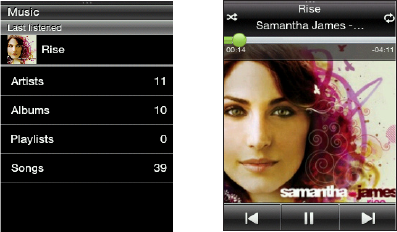
104 Chapter 7 Camera and multimedia
Library Music player
From the Music player, press MENU, and then tap Now playing list to
see a list of music tracks from your selected category.
Working with playlists
Personalize your music experience by creating music playlists. Make
a playlist containing just your favorite songs or create one to match
your mood for the day. You can make as many playlists as you like.
Creating a playlist
1. Open the Music application, and then tap Playlists.
2. If there are no playlists yet, you tap Add playlist. Or, press MENU,
and then tap Create playlist.
3. Enter the playlist name.
4. To add songs to this playlist, tap a catalogue, and then browse
for the desired songs.
5. Select one or more songs, and then tap Add.

Chapter 7 Camera and multimedia 105
Editing a playlist
1. Open the Music application, and then tap Playlists.
2. Tap the playlist to edit.
3. Press MENU, and then tap any of the following:
Rename playlist. Enter a new playlist name.
Add songs. Select a catalogue, and then browse for the
desired songs. Select one or more songs, and then tap Add.
Change order. Press and hold the Change order icon ( ),
drag the song to the desired song order, and then tap OK.
Remove songs. Select the songs to remove from the playlist,
and then tap OK.
Deleting a playlist
1. Open the Music application, and then tap Playlists.
2. Press MENU, and then tap Delete playlists.
3. Select one or more playlists, and then tap Delete.
•
•
•
•
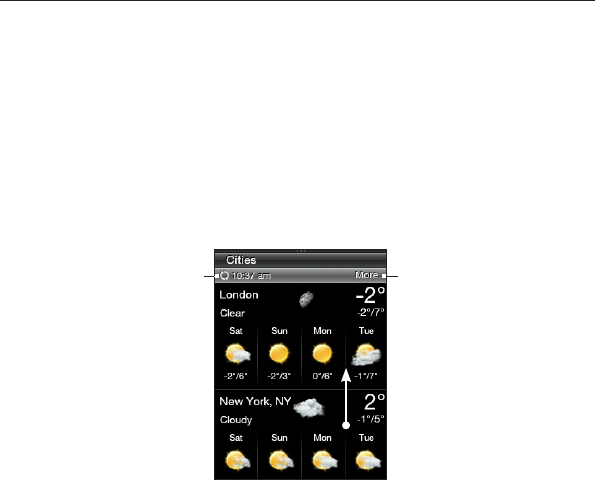
Chapter 8
More apps
Weather
You can use the Weather application to check the current weather
and weather forecasts for the next four days of the week. In addition
to your current location’s weather, this application also displays the
weather forecasts of your selected cities.
Opening Weather
Do any of the following:
From the main Home screen, slide to the Weather screen. Tap the
current weather information to open the Weather application.
Open the All programs panel, and then tap Weather.
Slide up to view
weather forecasts of
cities you’ve added.
Shows the
time weather
information was
last updated.
Tap to open your
phone’s web browser
and check more
weather information
on the website.
Tip If you have not enabled automatic Weather updates, press MENU, and
then tap Refresh to manually download the current weather information.
•
•

Chapter 8 More apps 107
Adding cities
The Weather application can display weather information of up to five
cities, including your current location.
1. Open the Weather application.
2. Press MENU, and then tap Add. If there are no cities included,
you can tap the text that says “Tap here to add city”.
3. Enter the first few letters of a country or city name. Weather
displays a matching list of locations.
4. Scroll through the list, and then tap the name of the desired city.
Your phone then downloads the city’s weather information.
Deleting cities
1. Open the Weather application.
2. Press MENU, and then tap Delete.
3. Select one or more cities to remove, and then tap Delete.
Weather settings
Open the Weather application, press MENU, and then tap Settings.
Setting Description
Download weather
automatically
When this option is turned on, weather information is
automatically downloaded at the set download time.
Update frequency Tap to set an auto-update schedule of weather
information.
Download weather
when roaming
Turn this option on only if you want to allow
automatic download of weather information when
roaming. This may incur additional data charges.
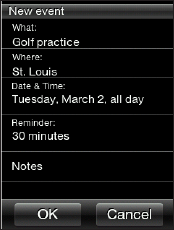
108 Chapter 8 More apps
Calendar
Use your phone’s Calendar to create and manage your events,
meetings, and appointments.
Opening Calendar
Do any of the following:
Tap the Calendar icon if you see it on the main Home screen.
Open the All programs panel, and then tap Calendar.
If you added the Calendar feature to your Home screen, slide to
the Calendar screen. Tap a day to view the events of that day.
Adding an event
1. Open Calendar.
2. Press MENU, and then tap New.
Otherwise, tap another date on the
calendar, and then tap Add new event.
3. Enter a name for the event.
4. Enter the event location.
5. Tap Date & Time, and then set the Start
and End dates and times.
Otherwise, if it is a special occasion such
as a birthday or a whole-day event, tap
All day event. Tap OK.
6. Tap Reminder, and then choose how soon before the event you
want to be notified.
7. When done, tap OK.
•
•
•
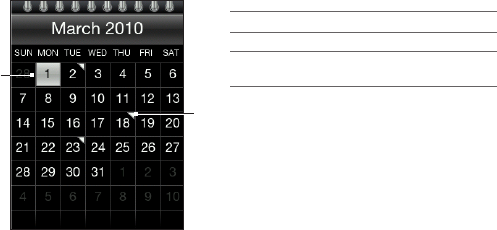
Chapter 8 More apps 109
Viewing an event
To check what events you have during a certain date, tap a date on
the month calendar. The calendar changes to Day view and displays all
your events for that day. Tap an event to view the complete details of
that event.
Changing Calendar views
When you open Calendar for the first time, the application displays
the Month view by default. You can press MENU, and then choose the
type of calendar view that you want.
Month view
In Month view, you’ll see markers on days that have events. Tap a day
to view the events of that day.
1
1 Current date
2 Event markers
Slide up and down the screen to view
the next or previous month.
2
Day and Agenda views
Day view displays a list of the events of one day. When in Day view,
slide left or right across the screen to view earlier or later days.
Agenda view shows a list of all your events in chronological order.
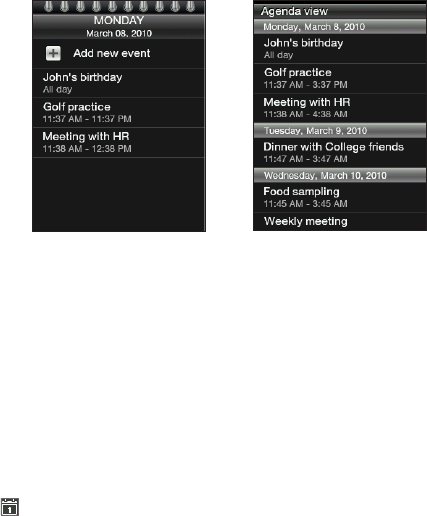
110 Chapter 8 More apps
Day view Agenda view
Editing an event
1. Open Calendar.
2. In Month view, tap the day when the event takes place, and then
tap the event to open it.
3. Press MENU, and then tap Edit.
4. Make your changes to the event.
5. When done, tap OK.
Viewing event reminders
If you have set at least one reminder for an event, the upcoming event
icon ( ) will appear in the status bar or on the lock screen to remind you of
the upcoming event. Open the Notifications panel, and then tap the upcoming
event notification to view the event or dismiss the reminder.
Chapter 8 More apps 111
Sending event details
1. Open Calendar.
2. Tap an event to view the complete details of that event.
3. Press MENU, and then tap Send > Send via email or Send via
Bluetooth. To learn more about the Mail application, see “Email
Messages” in Chapter 5. For more details on sending files via
Bluetooth, see “Using Bluetooth” in Chapter 6.
Deleting an event
In Month view, tap the day when the event takes place, and then tap
the event to open it. Press MENU, and then tap Delete.
Alarm
You can use Alarm to set up one or more wake-up alarms. To open
this application, you can:
Tap the weather clock on the main Home screen.
Open the All programs panel, and then tap Alarm.
Setting an alarm
1. Open Alarm, and then tap Add alarm.
2. Tap Time, enter the alarm time, and then tap OK.
3. Tap Repeat, select the days when to sound the alarm, and then
tap OK.
4. Set other options such as when to snooze the alarm, the alarm
sound to play, or if you want your phone to also vibrate when the
alarm goes off.
5. When done, tap Save.
•
•
112 Chapter 8 More apps
Editing an alarm
1. Open Alarm.
2. Tap an alarm to edit.
3. Tap a field to edit, and then enter the new information.
4. When done, tap Save.
Deleting an alarm
Open Alarm, press MENU, and then tap Delete. Select one or more
alarms, and then tap Delete.
File Browser
Store, locate, and easily manage files on your phone and storage card
with File Browser. To open this application, open the All programs
panel, and then tap File Browser.
Tip Press MENU, and then tap Properties to check the phone storage and
storage card usage.
Opening folders and files
1. Open File Browser.
2. Choose whether to open folders and files on the phone storage
or your storage card (if you have inserted one).
3. Tap a folder or file to open it.
Note When browsing through folders, press the BACK/HOME button to
return to an upper level folder.
Creating a folder
1. Open File Browser.
2. Go to where you want to create a new folder.
Chapter 8 More apps 113
3. Press MENU, and then tap New.
4. Enter a folder name.
Copying folders or files
1. Open File Browser.
2. Open the folder that contains the items you want to copy.
3. Press MENU, and then tap Copy.
4. Select one or more items, and then tap OK.
5. Open the folder where you want to paste the copied items, and
then tap Paste.
Moving folders or files
1. Open File Browser.
2. Open the folder that contains the items you want to move.
3. Press MENU, and then tap Move.
4. Select one or more items, and then tap OK.
5. Browse for a new location, and then tap Move.
Deleting folders or files
1. Open File Browser.
2. Open the folder that contains the items you want to delete.
3. Press MENU, and then tap Delete.
4. Select one or more items, and then tap OK.
Sorting files
1. Open File Browser.
2. Open a folder, press MENU, and then tap Sort.
3. Select a sort option, and then tap OK.
114 Chapter 8 More apps
Sending files
1. Open File Browser.
2. Browse for the folder that contains the items to send.
Note You can only send files supported on your phone such as photos,
videos and music files.
3. Press MENU, and then tap More > Send.
4. Choose how you want to send the files, and then select one or
more files.
5. Tap OK. To learn more about Messages and Mail, see
Chapter 5. For more details on sending files via Bluetooth, see
“Using Bluetooth” in Chapter 6.
Java
Use Java to download, install and manage MIDlets or MIDlet suites on
your phone. MIDlets are Java applications, such as games and tools
that can run on mobile devices, while a MIDlet suite is a collection
of one or more MIDlets. Your phone supports Java 2 Micro Edition
(J2ME).
To open this application, open the All programs panel, and then tap
Java.
Downloading and installing MIDlets/MIDlet suites
Using your phone’s web browser, you can download and install
MIDlets/MIDlet suites from the Internet.
1. Open a web page with the link for the MIDlet/MIDlet suite you
want to download. To know more about using your phone’s web
browser, see “Browsing the Web” in Chapter 6.
2. On the web page, tap the link to start downloading the Java
application.
Chapter 8 More apps 115
3. Follow the onscreen instructions to install and run the MIDlet/
MIDlet suite.
Copying and installing MIDlets/MIDlet suites on your
phone
You can copy MIDlets/MIDlet suites from your computer to your
phone using your storage card. To learn how to copy files to your
microSD card, see “Copying files to or from your storage card” in
Chapter 2.
1. Open Java.
2. On the Java MIDlets screen, tap Menu > Storage.
The application then searches for MIDlets/MIDlet suites on your
phone and displays them in a list.
3. Tap the MIDlet/MIDlet suite, and then tap Install.
4. Follow the onscreen instructions to install and run the
MIDlet/MIDlet suite.
Running a MIDlet/MIDlet suite
After installing MIDlets or MIDlet suites, you can open Java to see
your installed applications. On the Java MIDlets screen, double-tap an
application to open it.
Uninstalling a MIDlet/MIDlet suite
Before you uninstall a MIDlet, make sure that it is not running.
1. Open Java.
2. On the Java MIDlets screen, tap an application to remove.
3. Tap Menu > Remove.
4. When prompted, tap Remove.
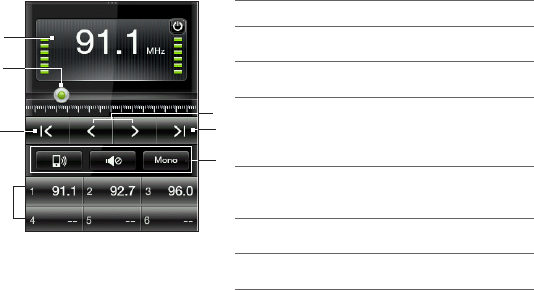
116 Chapter 8 More apps
FM Radio
Before opening FM radio, you need to connect a stereo wired headset
to the audio jack of your phone.
To open this application, you can:
Open the All programs panel, and then tap FM Radio.
Tap the FM Radio icon if you see it on the main Home screen.
1
1 Current FM radio frequency
2 Slide to tune in to any frequency in
the FM band.
3 Search the FM band for the previous
FM station.
4 Preset FM stations. Tap a preset
station to tune in. To add a preset,
tune in to an FM station, and then
press and hold a preset slot.
5 Tap these buttons to turn speaker
on or off, mute FM Radio, or switch
between Stereo and Mono.
6 Search the FM band for the next FM
station.
7 Fine tune the radio frequency by -0.1
MHz or +0.1 MHz.
2
3
4
7
6
5
The first time you open FM Radio, it automatically scans available FM
stations, saves them as presets, and plays the first FM station found.
Tip To repeat scanning and saving of FM stations, press MENU, and then tap
Scan & Save.
•
•

Chapter 8 More apps 117
Minimizing or turning off FM Radio
When you press the BACK/HOME button, FM Radio continues to run
in the background so you can continue listening while you use other
applications. To turn off FM Radio, tap on the upper right corner of
the FM Radio screen.

Chapter 9
Managing your phone
Changing the phone’s basic settings
Your phone’s basic settings can be easily customized to suit your
needs.
Changing the time zone, date, and time
1. From the main Home screen, press MENU, and then tap
Settings > Date & time.
2. Make sure that Automatic is set to OFF to disable network-
provided date, time, and time zone.
3. To set the time, do any of the following:
Tap Set time, adjust the time, and then tap OK.
Tap Select time zone, and then enter the first few letters of a
country or city name. Scroll through the list, and then tap the
name of the desired city.
4. Tap Set date, and then tap a date on the calendar.
5. Choose how you want the date and time to be displayed.
6. Press and hold the BACK/HOME button to return to the main
Home screen and check if the date and time settings have
changed.
•
•
Chapter 9 Managing your phone 119
Selecting a phone profile
A profile determines how your phone will alert you when you have
incoming calls and notifications. To select a phone profile, do any of
the following:
From the main Home screen, press MENU, tap
Settings > Sound > Profile, and then select a phone profile.
Press and hold the POWER button, and then tap Silent mode or
Vibrate only. Press and hold the POWER button again when you
want to change back to Normal ringer.
Changing your ringtone
When the phone profile is set to Normal mode, you can easily assign
a favorite song saved on your phone or storage card as your new
ringtone.
Note The selected audio file should be in a supported ringtone format such as
*.mid and *.mp3.
1. From the main Home screen, press MENU, and then tap
Settings > Sound.
2. Tap Phone ringtone.
3. Tap Phone ringtones to choose a preset ringtone or tap Audio
files to choose from your audio files.
Switching to Airplane mode
In many countries, you are required by law to turn off the phone
while on board an aircraft. A way to do this is to switch your phone
to Airplane mode. This turns off all wireless radios on your phone,
including the phone function, data connection, and Bluetooth.
•
•

120 Chapter 9 Managing your phone
Press and hold the POWER button, and then tap Airplane mode. The
Airplane mode icon ( ) then appears in the status bar.
Tip You can also turn Airplane mode on or off in Settings > Wireless
controls > Airplane mode.
Protecting your phone
Keep information on your phone safe by setting a SIM card PIN or a
lock password.
Protecting your phone with a lock password
1. From the main Home screen, press MENU, and then tap
Settings > Security > Phone lock code.
2. Enter a lock password, and then tap OK.
3. Confirm your lock password by entering it again, and then tap
OK.
After you have set a lock password, the Device lock screen will appear
and prompt you to enter your lock password every time you turn on
your phone or unlock the screen.
Notes • To ensure that you can always make emergency calls, do not begin
your lock password with the digits of your local emergency number.
• To turn phone lock off, tap Settings > Security > Phone lock code,
and then tap Disable passcode. Enter your current lock password,
and then tap OK.
• If you forget your lock password, you’ll have to factory reset to be
able to remove the passcode and use your phone. For details, see
“Performing a factory reset while phone is turned off” in this chapter.
Chapter 9 Managing your phone 121
Protecting your SIM card with a PIN
1. From the main Home screen, press MENU, and then tap
Settings > Security > PIN code.
2. Enter the current SIM card PIN, and then tap OK.
Note Emergency calls can be placed at any time, without requiring a PIN.
Unblocking a SIM card that has been locked out
If you enter the wrong PIN more times than the maximum number
of attempts allowed, your SIM card will be locked. You need a PUK
code (PIN Unlocking Key) to restore access. This code may have been
provided when you received your SIM card. If the PUK code is not
provided or you lost it, contact your mobile operator.
1. Enter the PUK code, and then tap OK.
2. Enter a new PIN, and then tap OK.
3. Confirm your new PIN, and then tap OK.
Settings on your phone
To access all your phone’s settings, do any of the following:
From the main Home screen, press MENU, and then tap Settings.
Open the All programs panel, and then tap Settings.
Personalize
Customize the look and feel of the Home screen. For details, see
“Personalizing the Home screen” in Chapter 2.
•
•

122 Chapter 9 Managing your phone
Wireless controls
Airplane mode Enable or disable all wireless connections.
Bluetooth Turn Bluetooth on or off.
Bluetooth
settings
Make your phone discoverable by other Bluetooth devices,
search for other nearby Bluetooth devices, and more. For
details, see “Using Bluetooth” in Chapter 6.
Mobile network Connect or disconnect the active data connection
(3G/GPRS, or EDGE).
Mobile network
settings
Check and change your data connection settings, if you
have problems connecting to the Internet on your phone.
Call settings
Set up call services such as voicemail, call forwarding, call waiting, and
caller ID. For details, see “Call settings” in Chapter 3.
Sound
Profile Switch your phone to Normal mode, Silent mode, or
Vibrate mode.
Vibrate feedback Choose whether to make your phone vibrate whenever
you receive calls and notifications.
Ringer volume Adjust the volume level of the phone ringtone and sound
notifications.
Media volume Adjust the volume level of music or video playback.
Alarm volume Adjust the volume level of an alarm.

Chapter 9 Managing your phone 123
Phone ringtone Select a ringtone for incoming calls. For details, see
“Changing your ringtone” in this chapter.
Notification
sound
Select a tone to play when your phone receives new
notifications.
Audible touch
tone
When turned on, you’ll hear a touch tone sound when
tapping the Phone dialer keys.
Display
Brightness Adjust the screen brightness.
Screen timeout Set the idle time before the screen turns off. Tap Never if
you do not want to turn off the screen even if the phone
is not in use.
Calibration Recalibrate the screen if you feel that the screen does not
respond accurately to finger taps.
Data services
Weather Turn automatic download of weather updates on or off
and set how often to download weather updates. For
details, see “Weather” in Chapter 8.
My Location Choose whether to allow your phone to automatically
determine your location through a third-party location
service. You can also set how often the location service
downloads and updates information about your current
location.
Facebook Log in or out of your Facebook account. You can also set
how often to download Facebook updates to your phone.

124 Chapter 9 Managing your phone
Twitter Log in or out of your Twitter account. You can set how
often to download Twitter updates to your phone.
E-Mail Enable or disable automatic email updates when roaming.
Security
PIN code Choose whether to enable and set a SIM card PIN. For
details, see “Protecting your SIM card with a PIN” in this
chapter.
Change PIN1 Change your SIM card PIN. You must know your old SIM
card PIN to be able to change to a new one.
Change PIN2 Change a new SIM card PIN 2. You must know your old
SIM card PIN 2 to be able to change to a new one.
Phone lock code Choose whether to enable and set a lock password for
protecting your phone. For details, see “Protecting your
phone with a lock password” in this chapter.
Factory reset Delete all data and restore the phone back to its initial
state. For details, see “Factory Resetting” in this chapter.
Date & time
If you have disabled My Location and automatic detection of date
and time, you can manually set the date and time on this screen. For
details, see “Changing the time zone, date, and time” in this chapter.

Chapter 9 Managing your phone 125
Locale & text
Select phone
language
Switch to another language to use on your phone on the
fly.
Text input settings Adjust the settings of the onscreen keyboard. For details,
see “Text input settings” in Chapter 1.
USB to PC
Set the type of connection to use whenever you connect your phone
to your computer, or select Always ask me if you want your phone
to always display a selection screen so you can choose the type of
connection. See “Connecting your phone to a computer” in Chapter 2
for details.
About phone
Check various information about your phone, such as the phone
software version, phone memory usage, and more.

126 Chapter 9 Managing your phone
Factory resetting
Need to start over? If you’re passing your phone on to someone else
or just want a fresh start, you can factory reset your phone. It’s not a
step to be taken lightly. Factory resetting your phone will delete all
your data. It returns the phone to the state it was in before the first
time you turned it on.
Important Be sure to back up data (contacts and files) that you want to keep
before you factory reset your phone.
Performing a factory reset via settings
1. From the main Home screen, press MENU, and then tap
Settings > Security > Factory reset.
2. Enter “1234”, and then tap OK.
Performing a factory reset while phone is turned off
1. Press and hold the VOLUME UP, VOLUME DOWN and POWER
buttons. You will then see this message on screen:
This operation will delete all
your personal data, and reset all
settings to manufacturer default.
Press Volume Down to restore
manufacturer default, or press
other keys to cancel.
2. Press the VOLUME DOWN button to perform the factory reset,
or press any other button to cancel the reset.
3. When prompted, press the VOLUME DOWN button to turn on
the phone.
Tip If your phone hangs or freezes, remove the battery, wait for a few
seconds, and then put it back in. After reinserting the battery, turn the
phone back on.

Index
A
Access point 85
Airplane mode 119, 122
Alarm 111
B
Battery
- battery compartment door 12
- charge battery 17
- insert 16
- remove 17
Bluetooth 90
Bookmarks 88
Bottom cover
- remove 11
Browsing the web 86
C
Calendar 108
- add events 108
- edit events 110, 111
- views 109
Call history 58
Calls
- answer 54
- conference call 57
- multiple calls 55
- reject 54
- settings 59
Camera 96
Connecting a Bluetooth headset for the
first time 92
Contact card 62
Contacts
- add 61
- copy to SIM card 62
- delete 63
- edit contact details 63
- find 62
- groups 64
E
Email accounts
- delete 83
- edit 79
- set up 77
- sync options 83
Email messages 77
- compose 80
- download attachments 82
- folders 83
- forward 82
- reply to 82
- view 81
Enter text 23
128 Index
F
Facebook
- link contacts 65
- log in 67
File browser 112
Finger gestures 21
FM radio 116
Folders
- copy 113
- create 112
- delete 113
Friend Stream 31, 66
H
Home shortcuts 40
- add 40
- remove 41
I
Internet 86
K
Keyboard language 26
L
Library 103
Lock screen 50
M
Mail 77
Messages 70
- conversations 73
- copy to SIM card 75
- delete 75
- forward 75
- multimedia messages 72
- reply to 74
- settings 76
- text messages 71
Multimedia messages
- compose 72
- view 74
Music 103
- Music screen 34
Music player 103
My Location 123
N
Notification LED 44
Notifications
- notification icons 44
- notification popup 44
Notifications panel 45
O
Onscreen keyboard 22
- Phone Keypad 23
- QWERTY 24, 25
P
People 60
- contact card 62
Personalize 38
- add home shortcuts 40
Phone dialer 51
Phone Keypad 23
Phone lock code 120
Photos 101
- slideshow 102
- view albums and photos 101
- watch videos 102
Index 129
Playlists 104
- create 104
- delete 105
- edit 104
Power
- turn o 50
- turn on 19
Prediction 26
Profiles 119
Q
QWERTY 24, 25
R
Receiving information and media files via
Bluetooth 95
Ringtones 119
S
Scenes 38
Sending information and media files
using Bluetooth 94
Settings 121
SIM card 13
- enable PIN 121
- SIM manager 62
- unblock 121
Sleep mode 50
Speed dial 52
Status bar 29
Status icons 43
Storage card 14
T
Text input settings 27
Text messages
- compose 71
Turning Bluetooth on or off 90
U
USB to PC 125
V
Volume 48
W
Wallpaper 41
Web browser 86
Web search 86
Word prediction 26
X
XT9 26